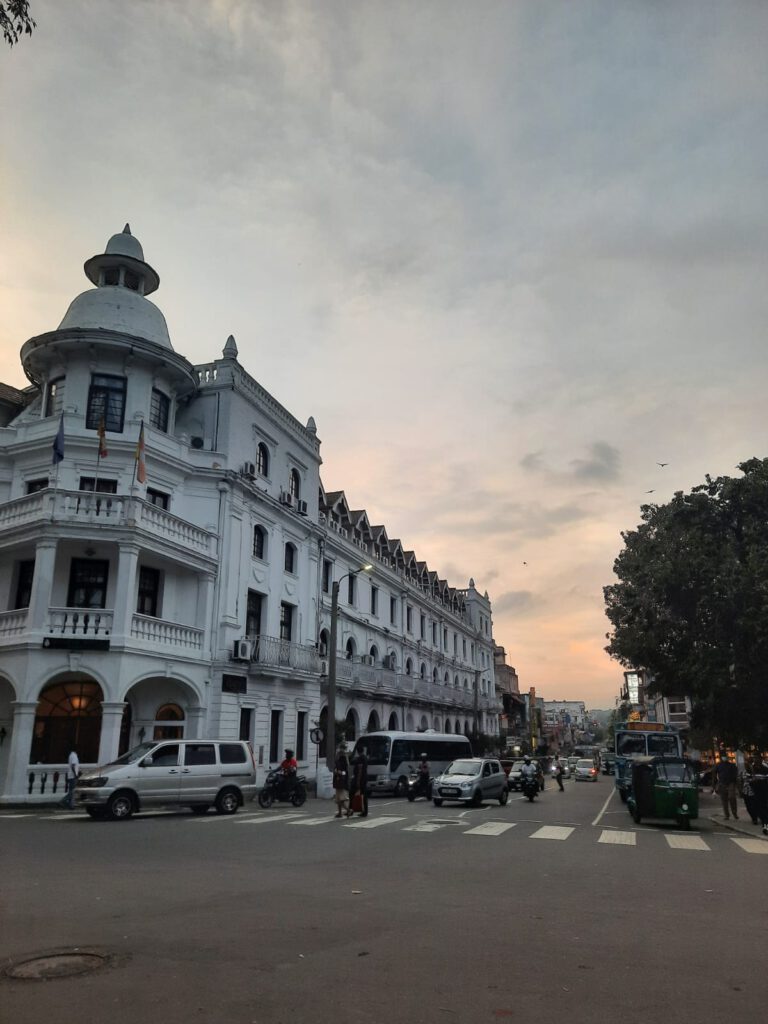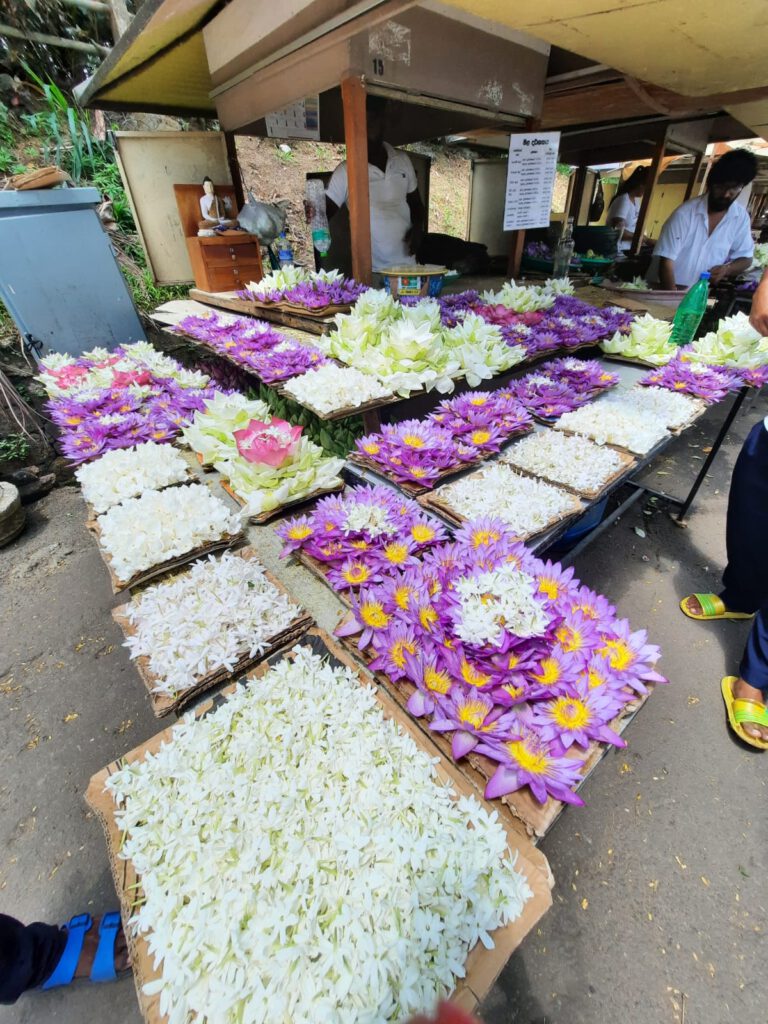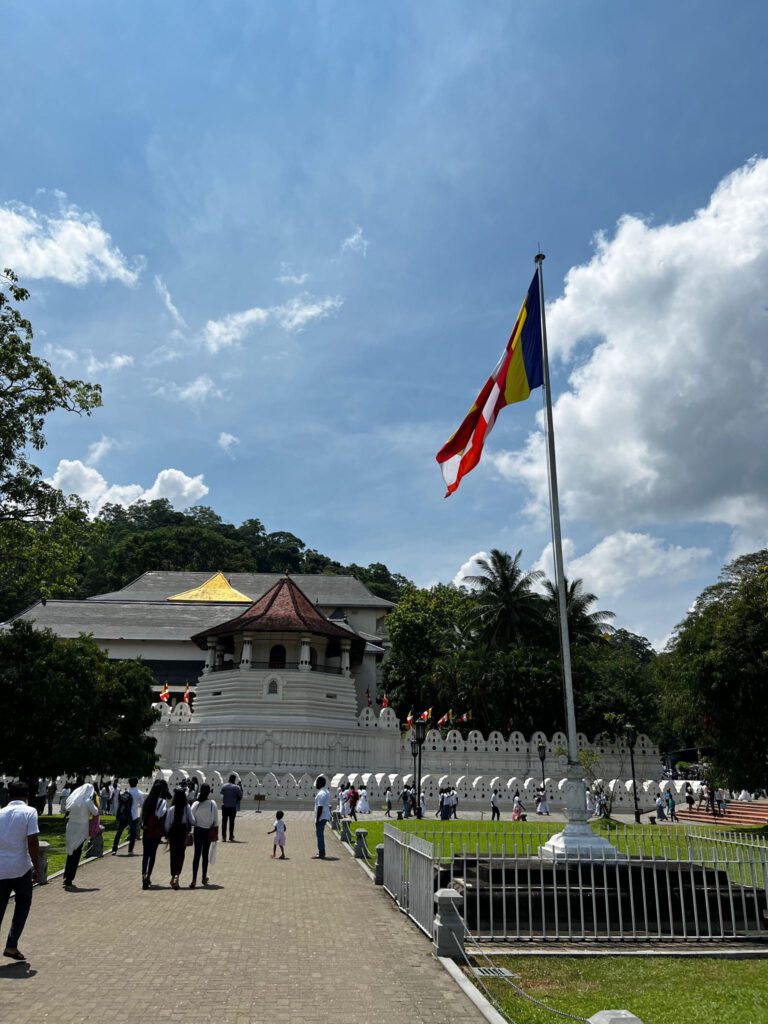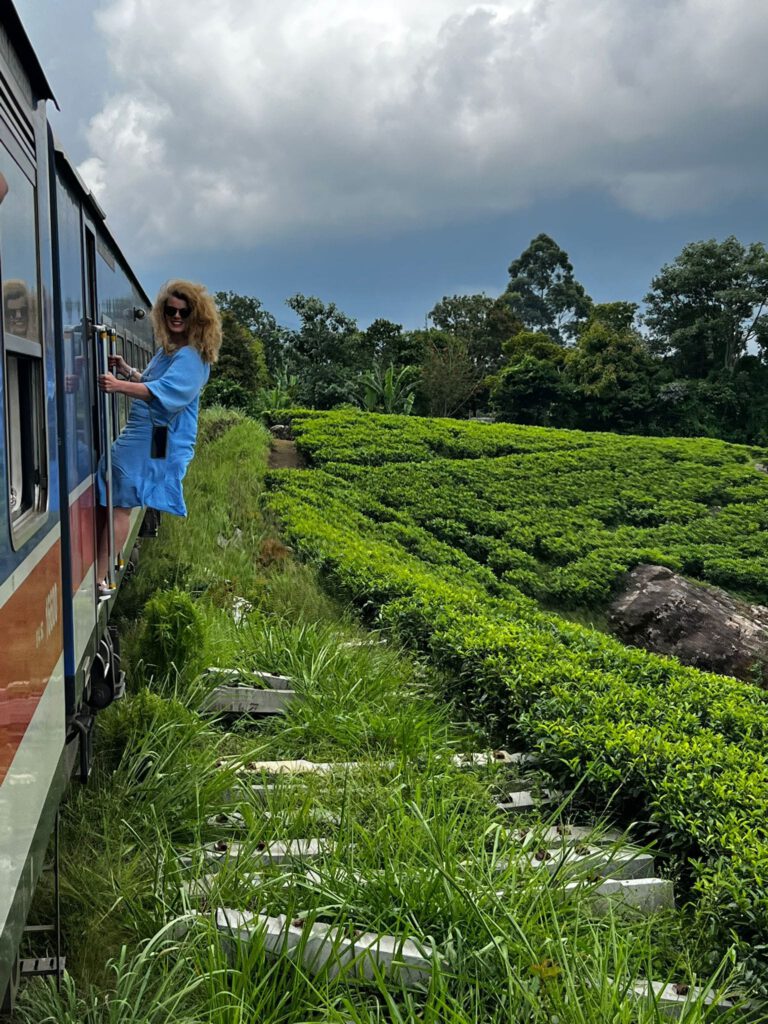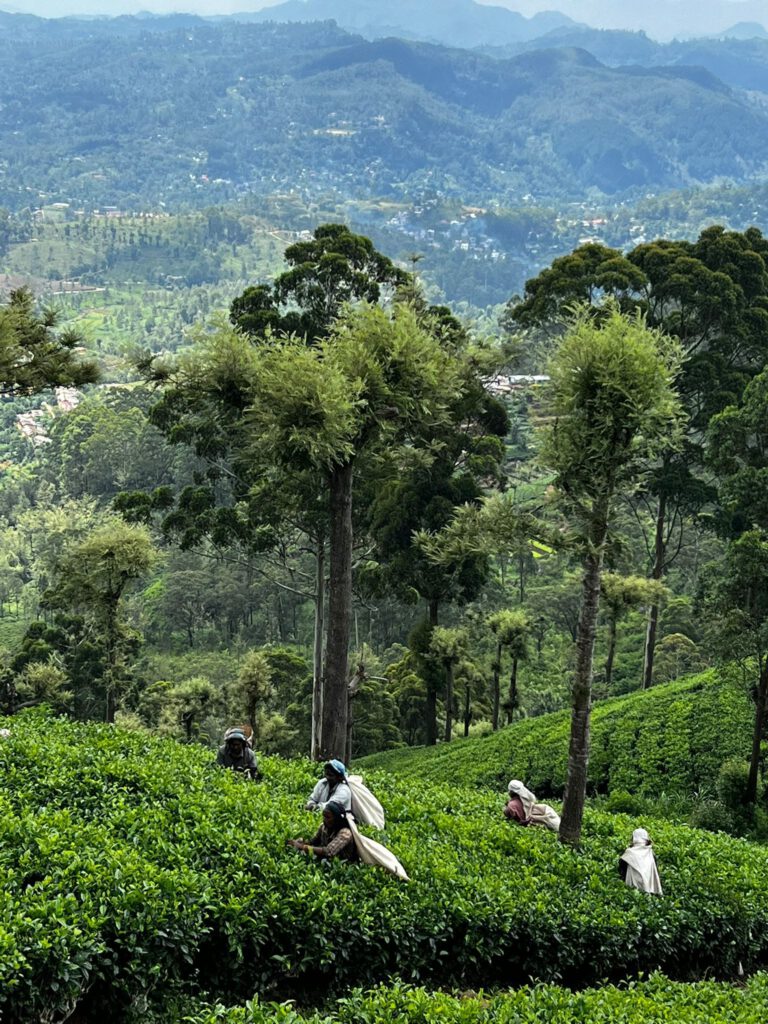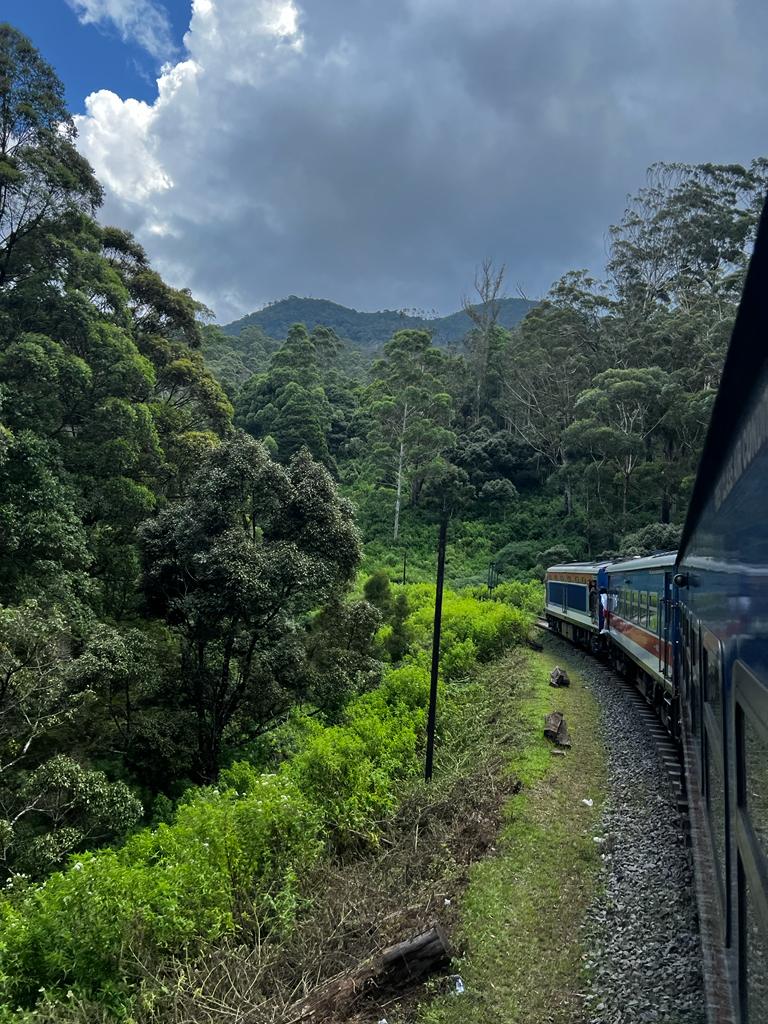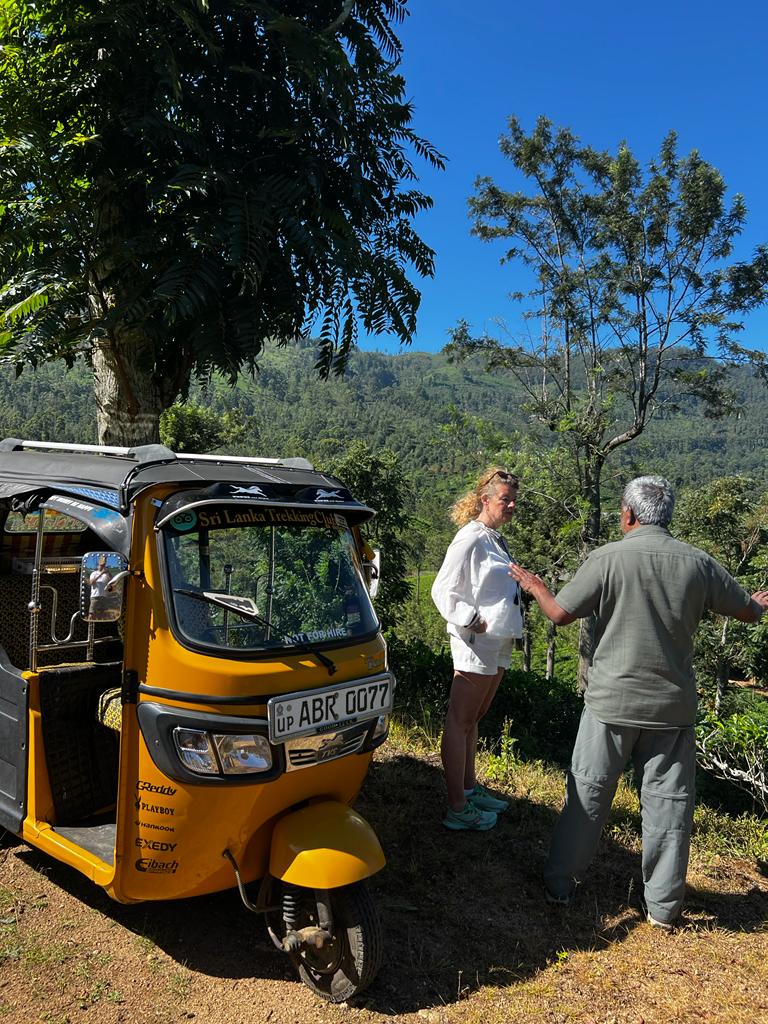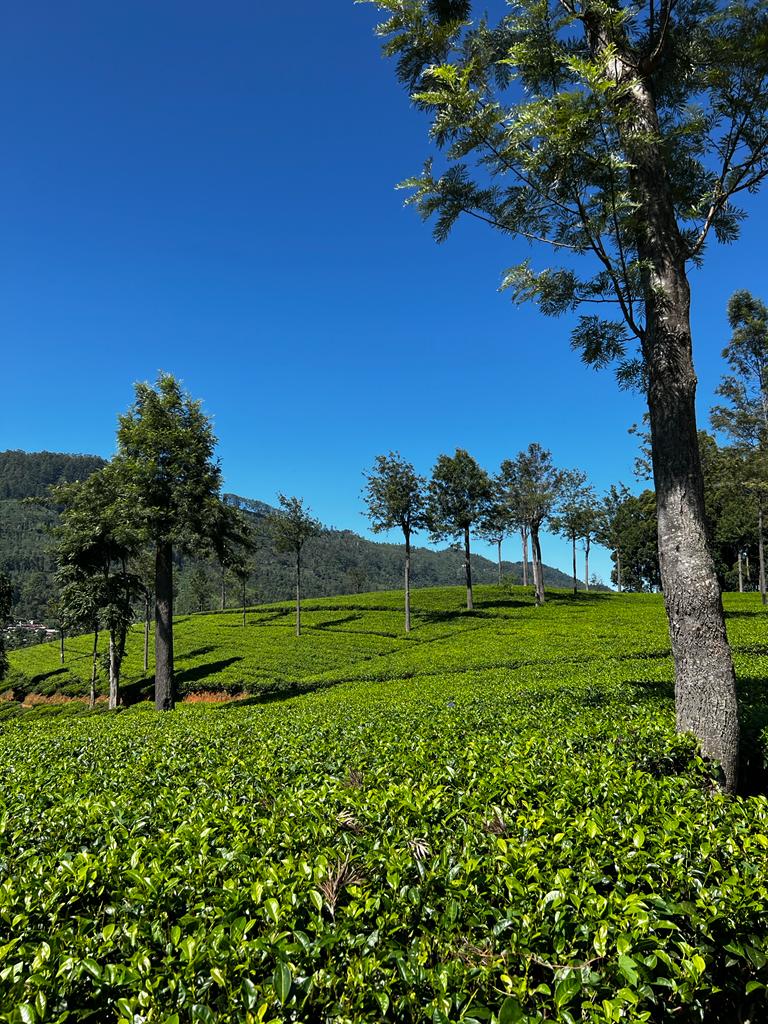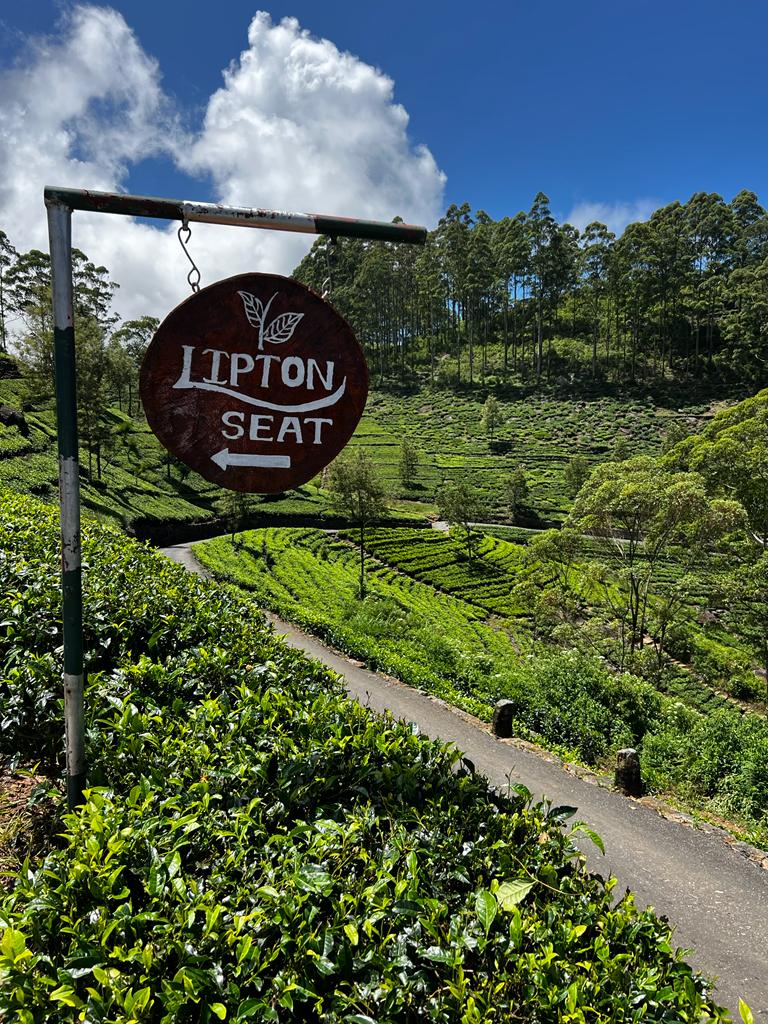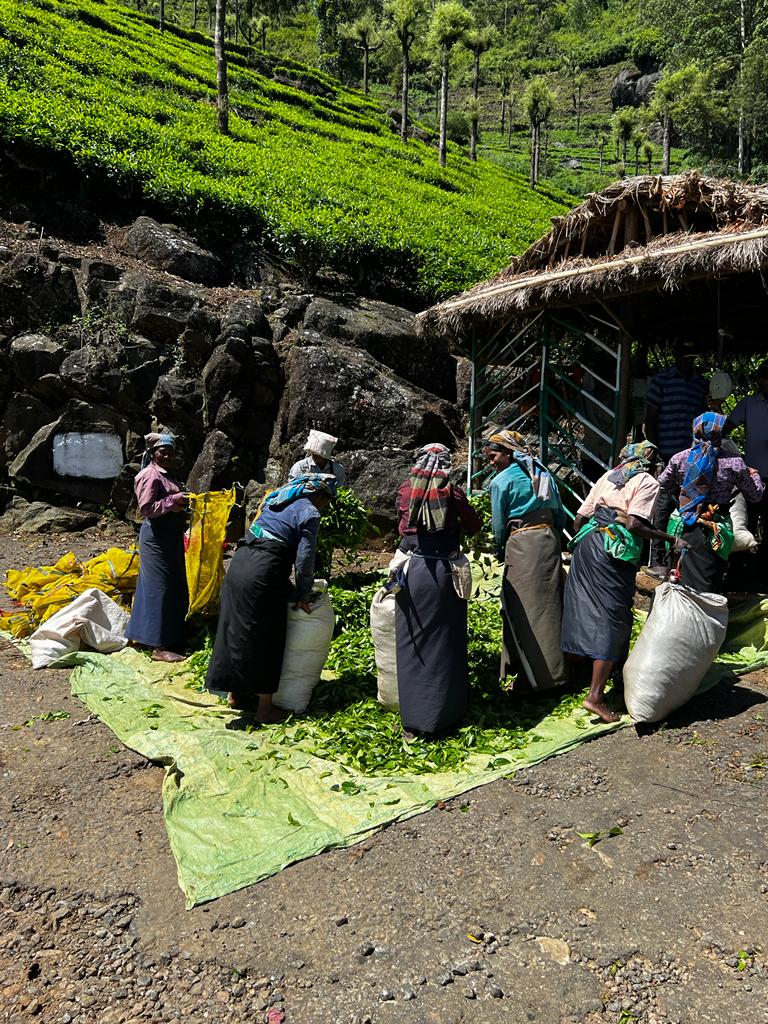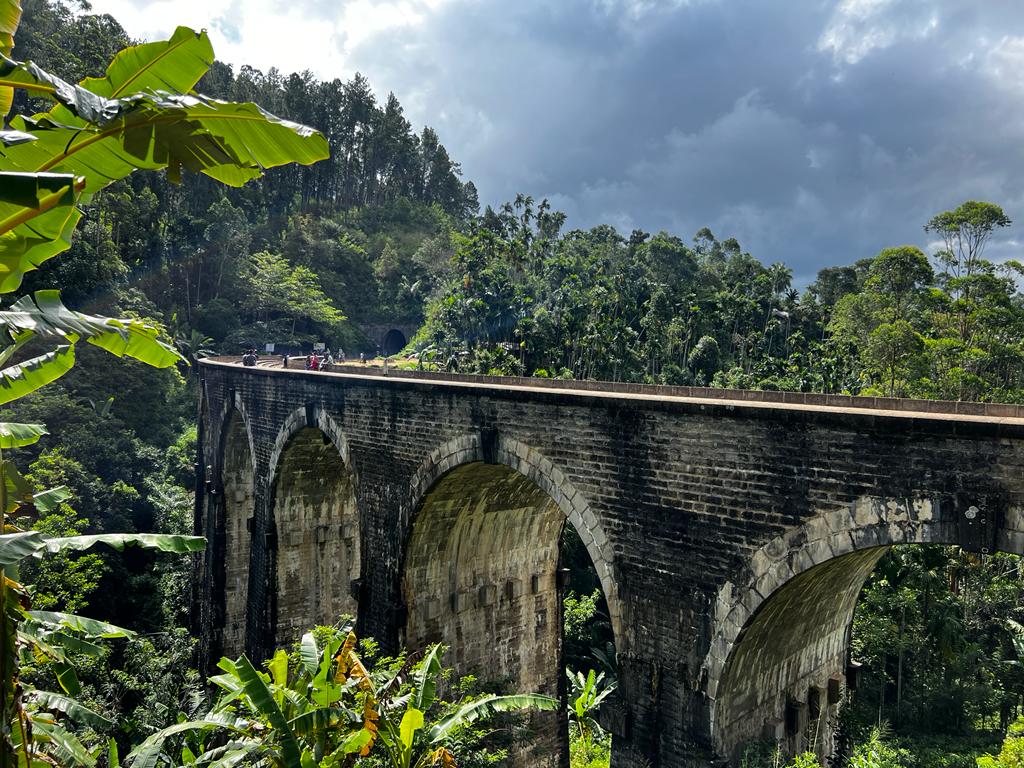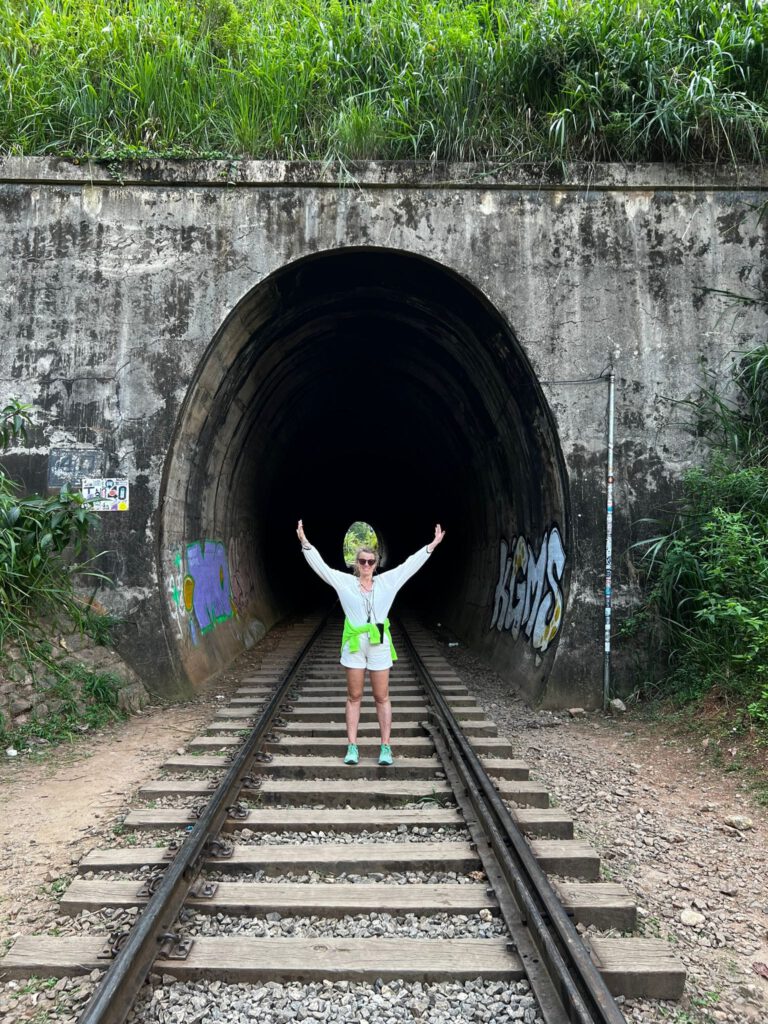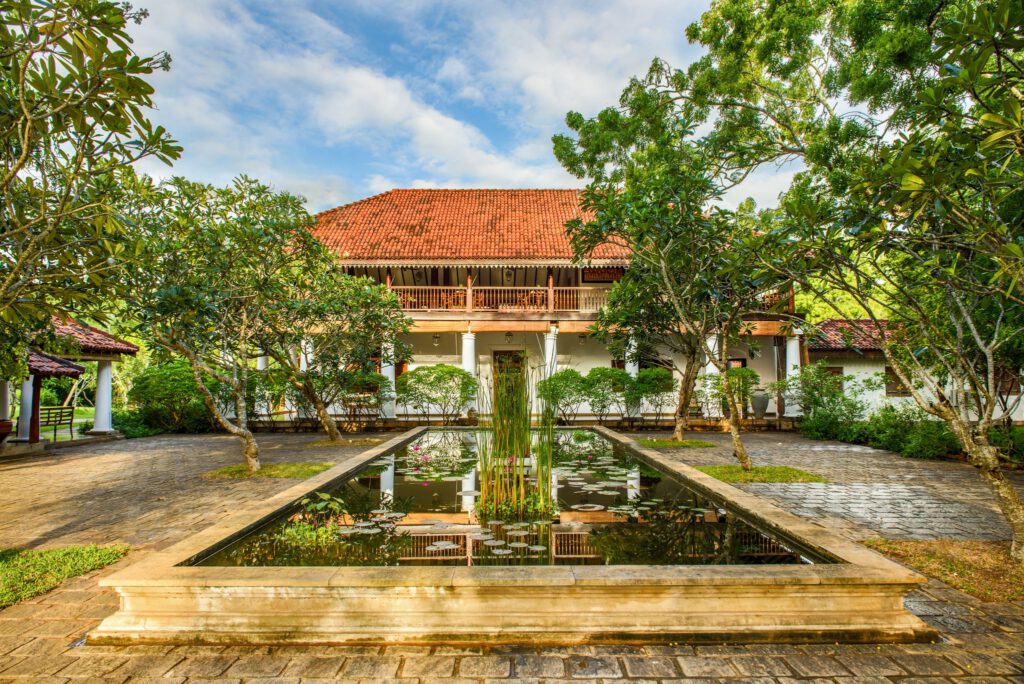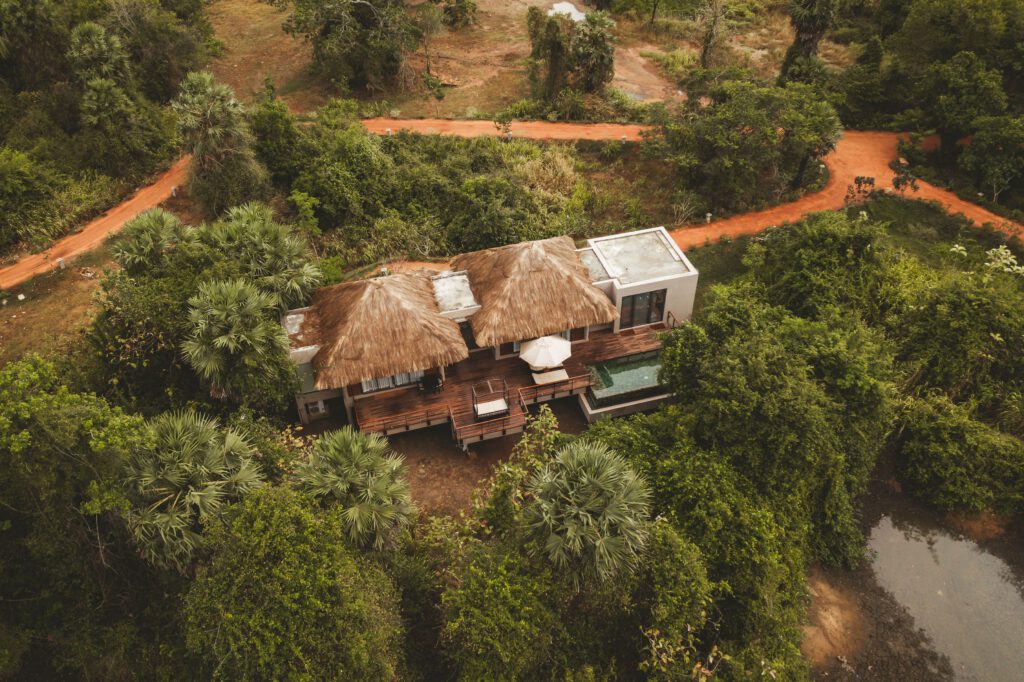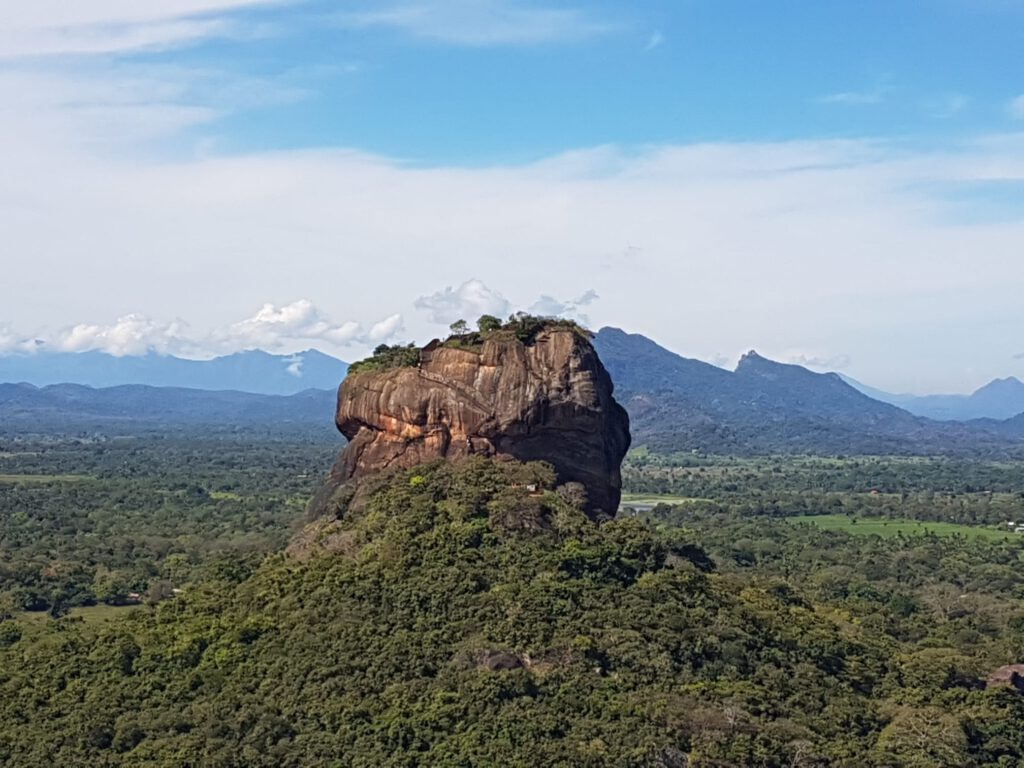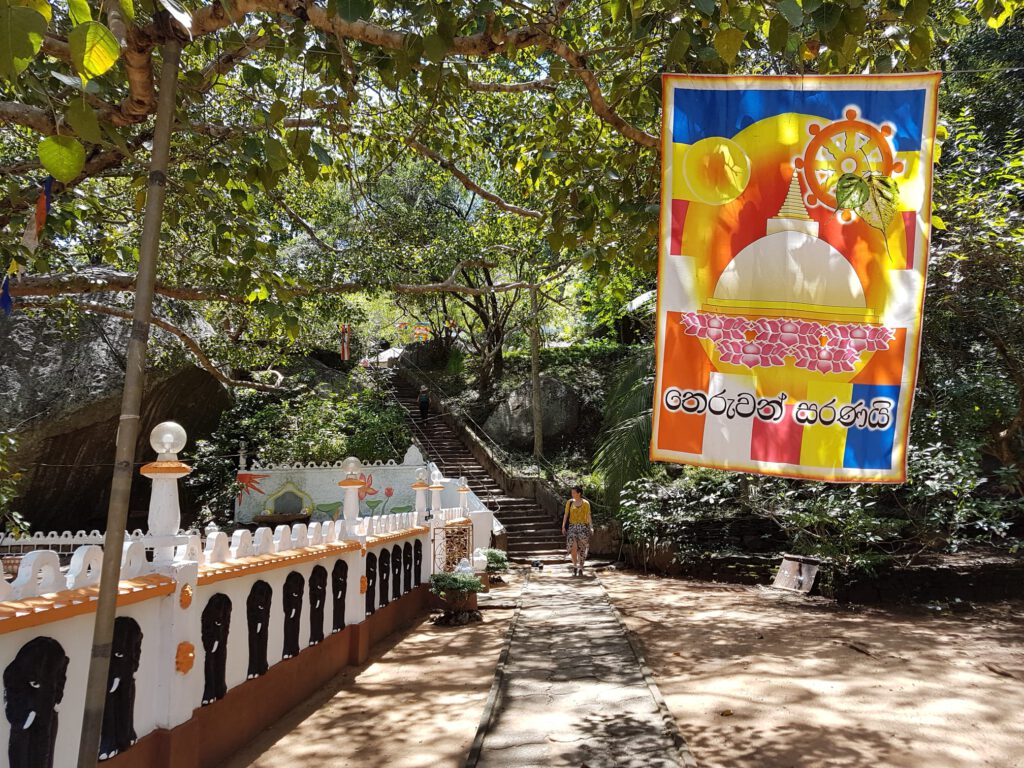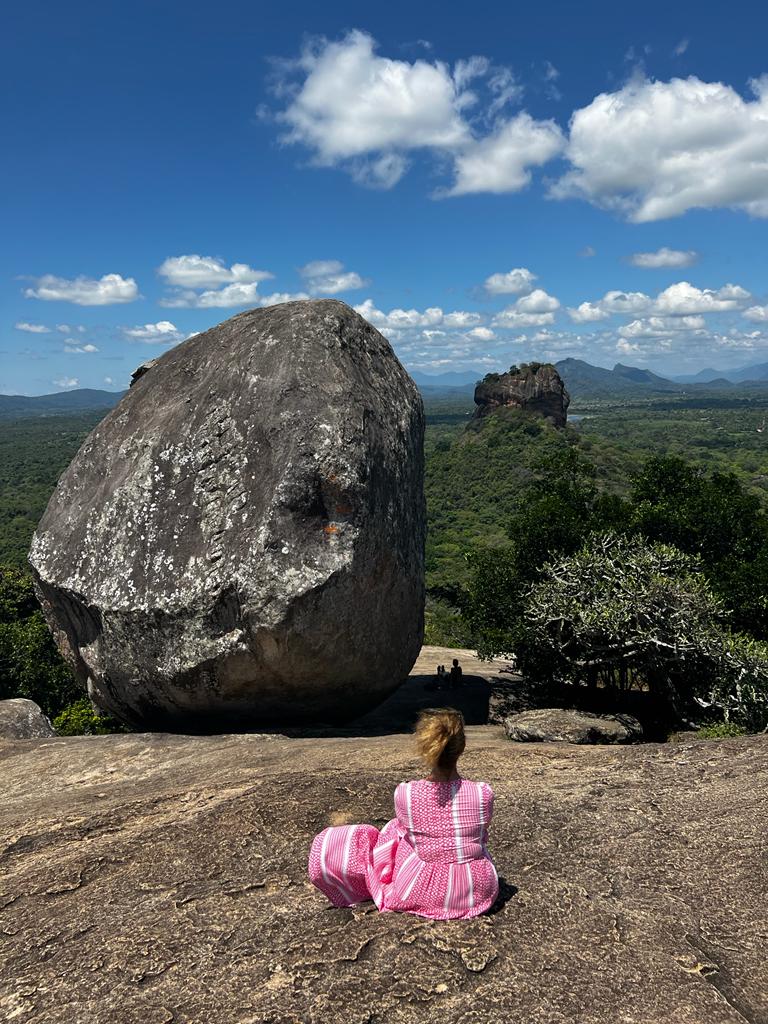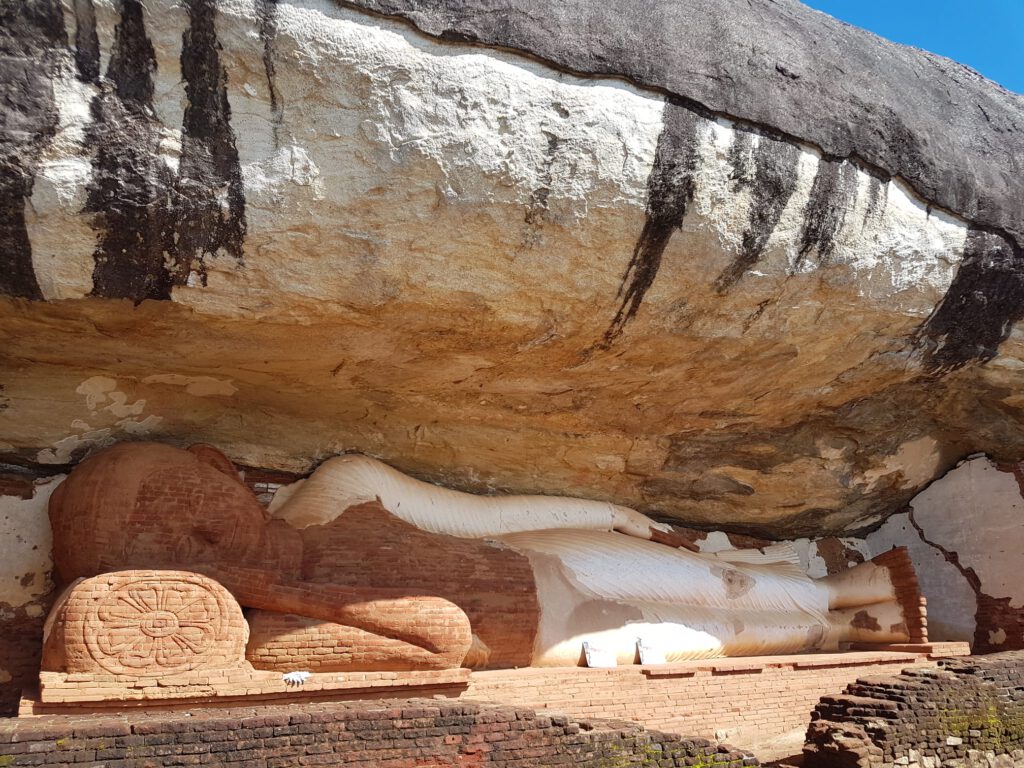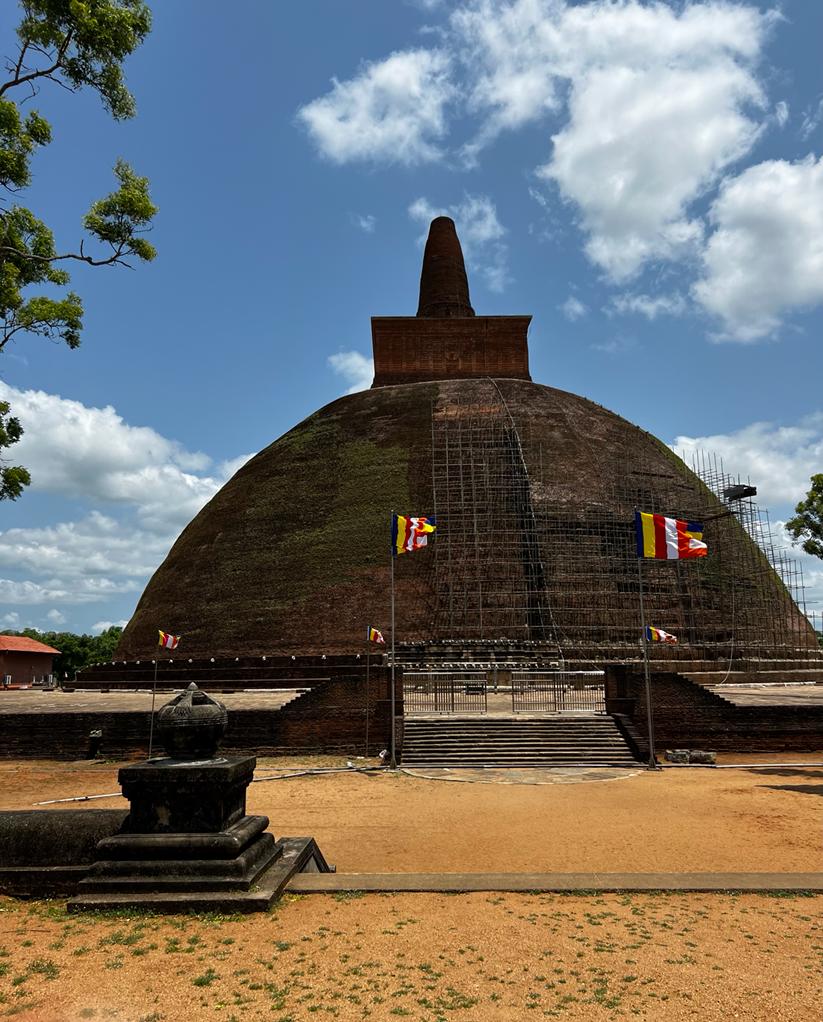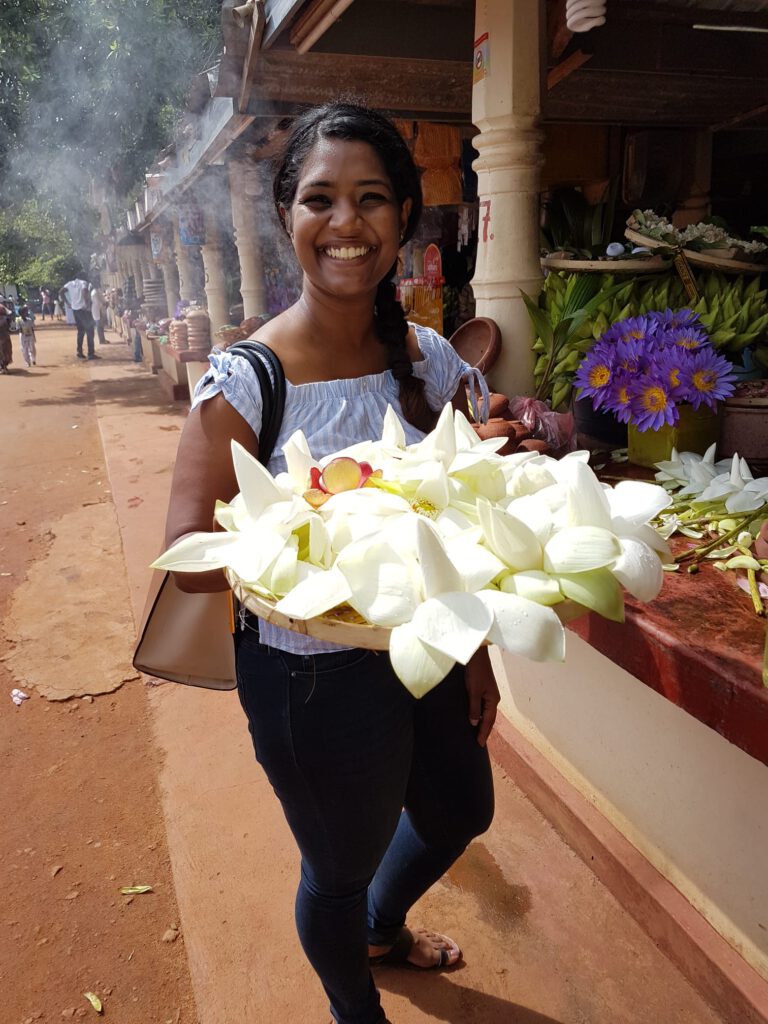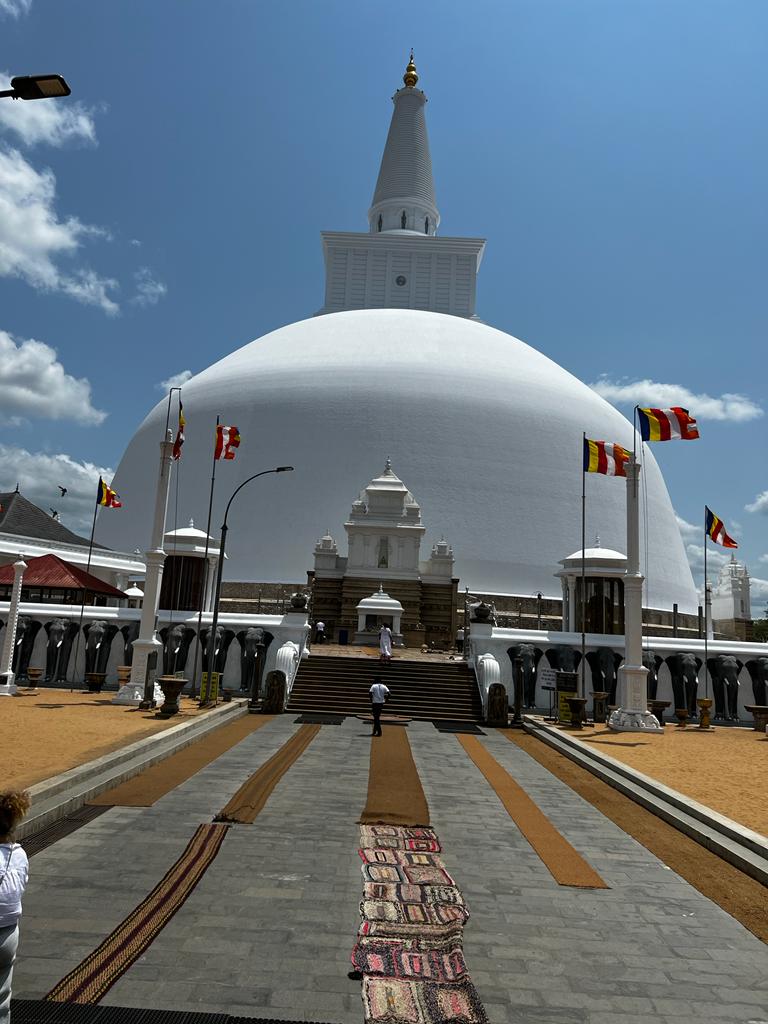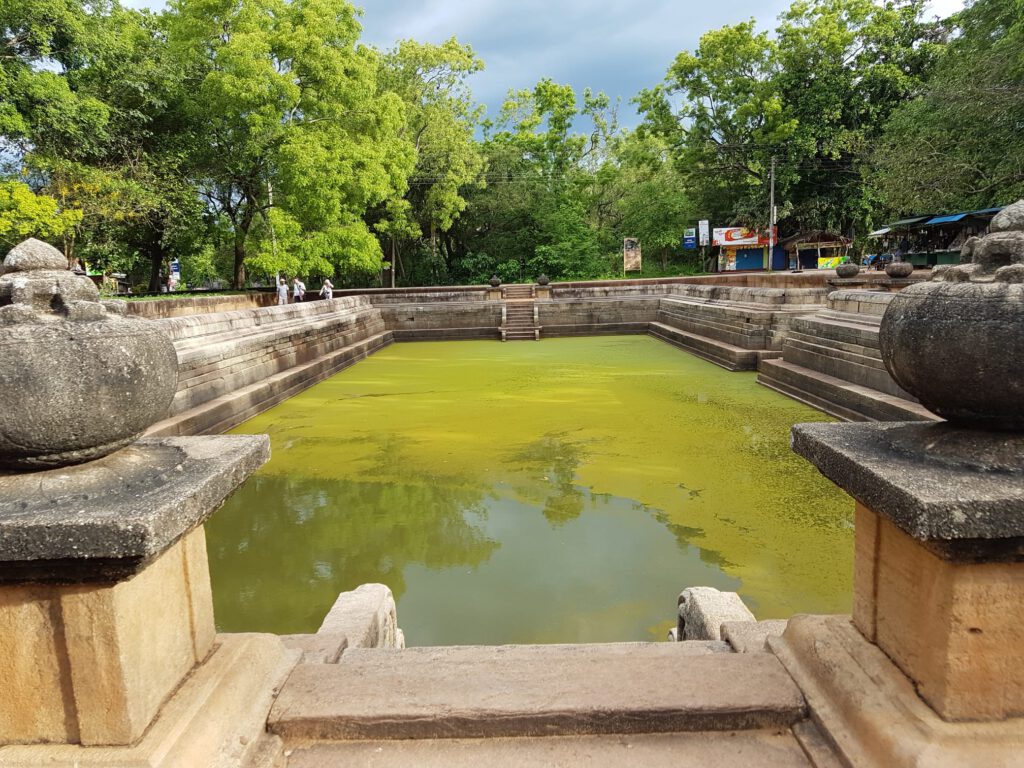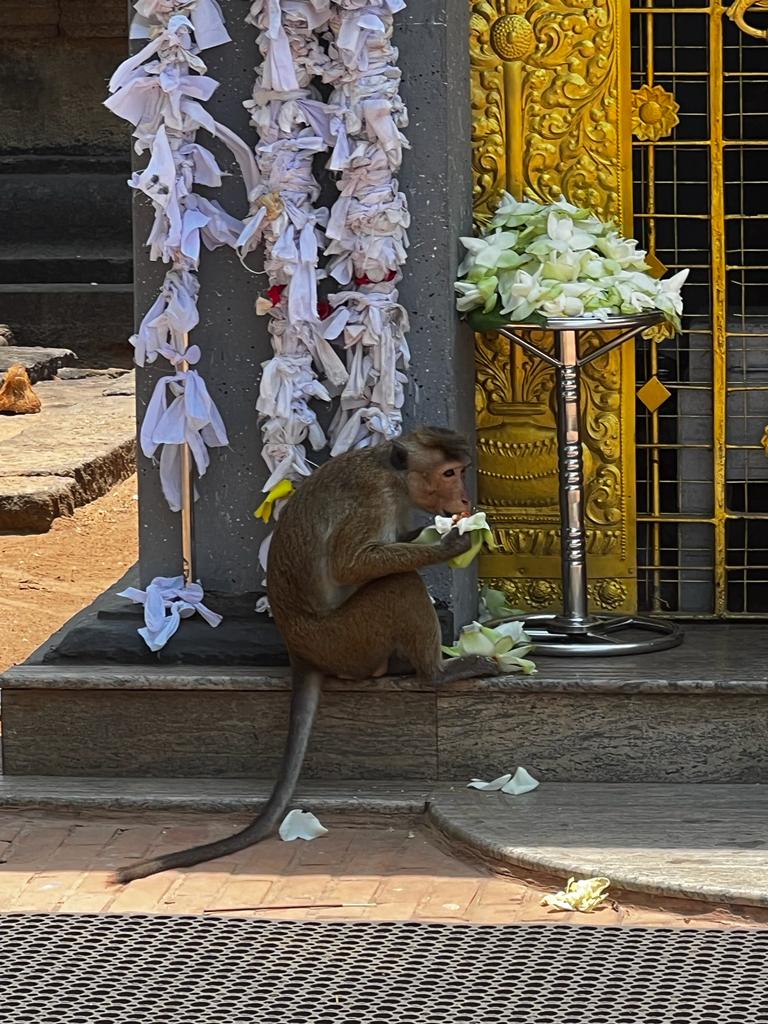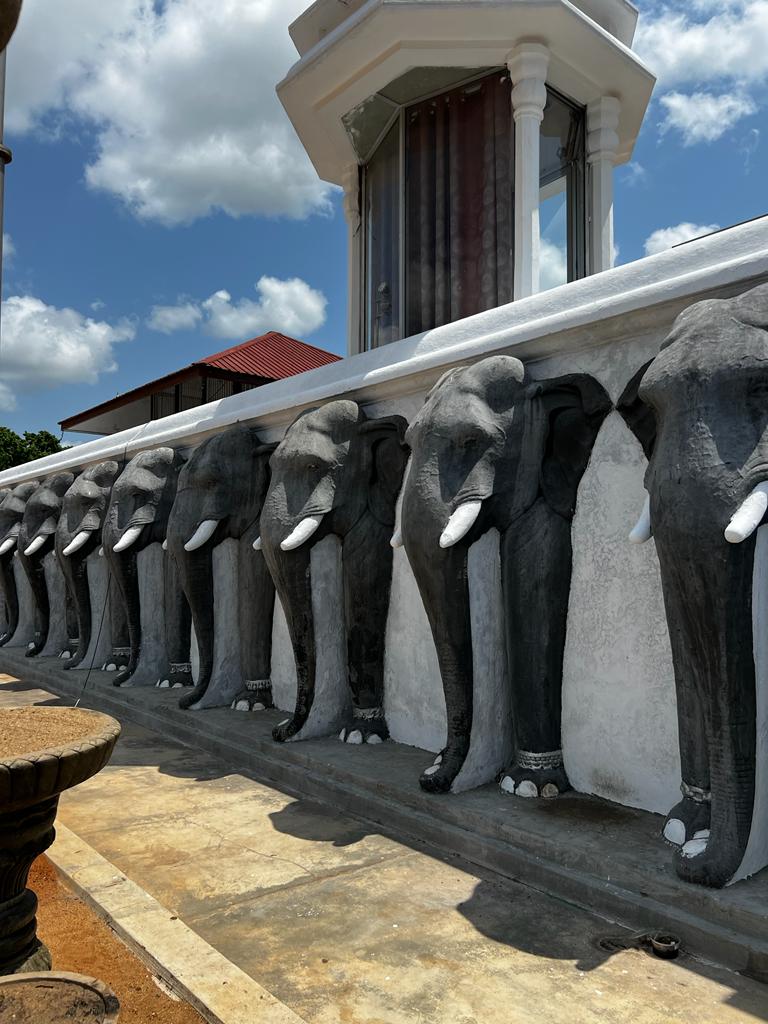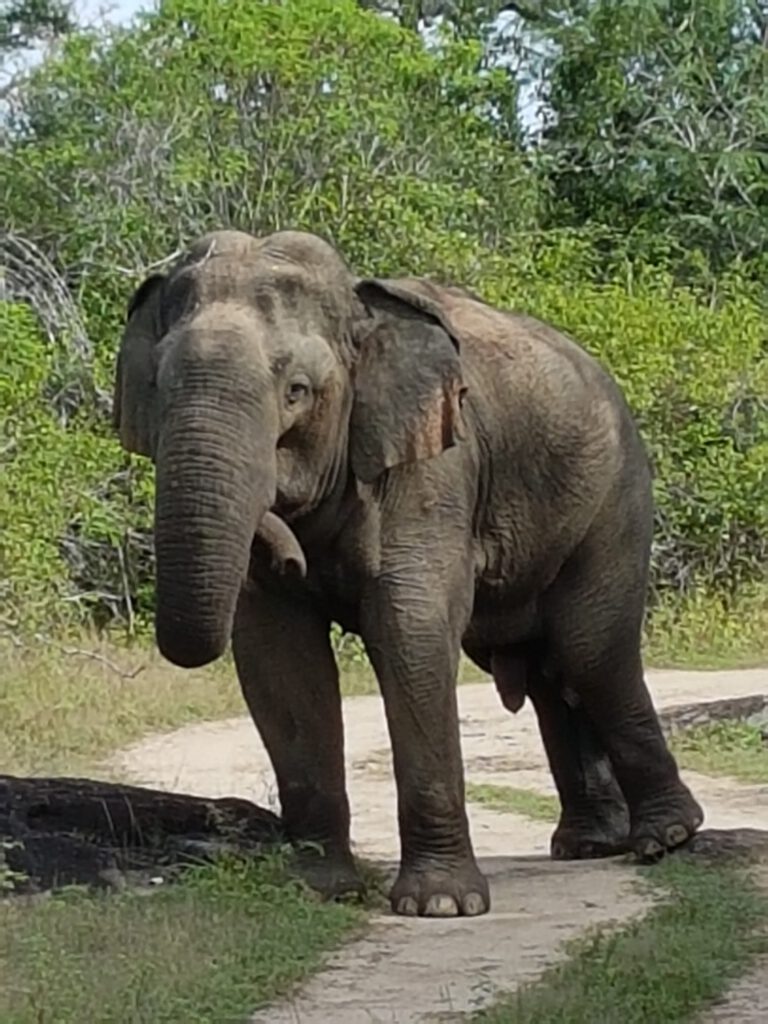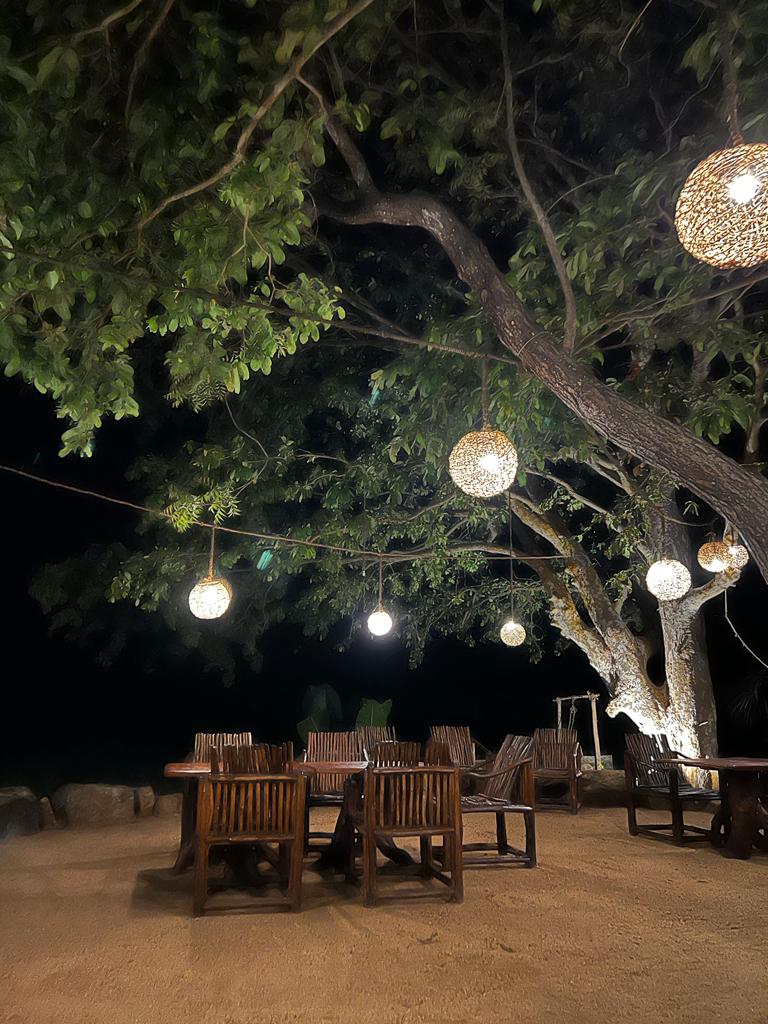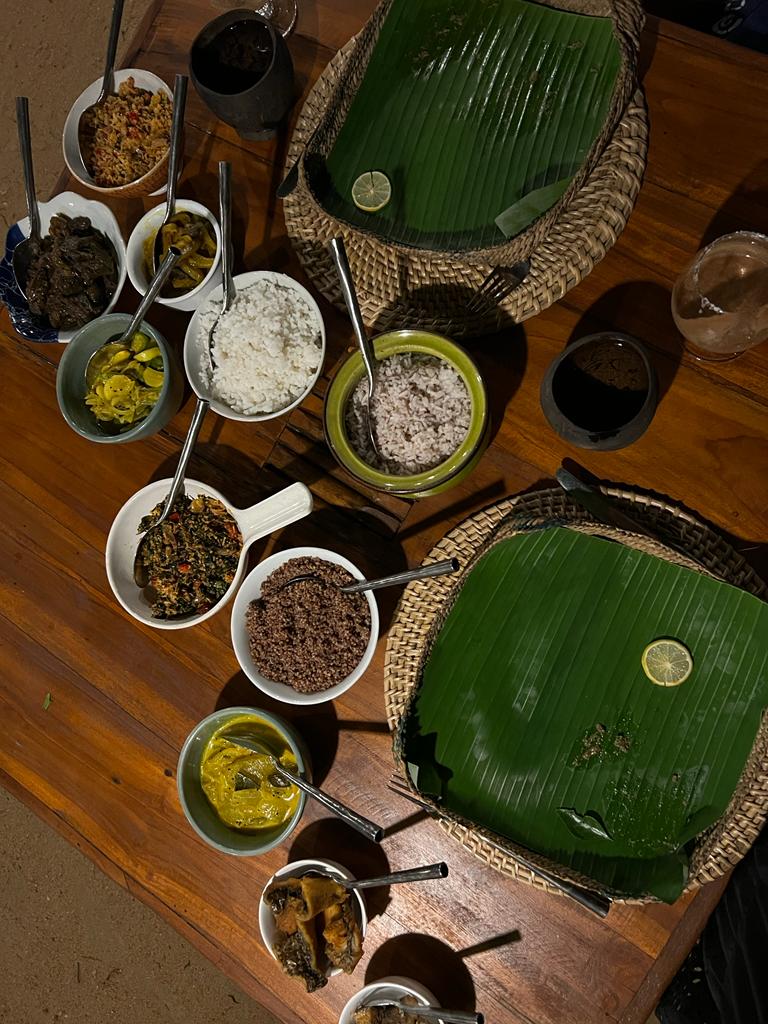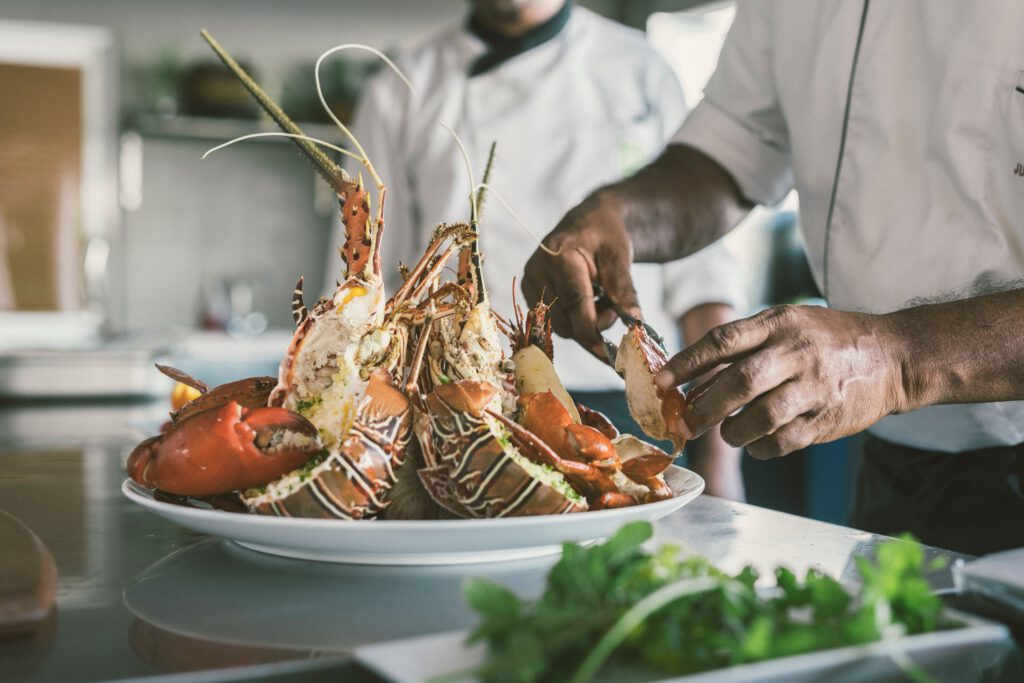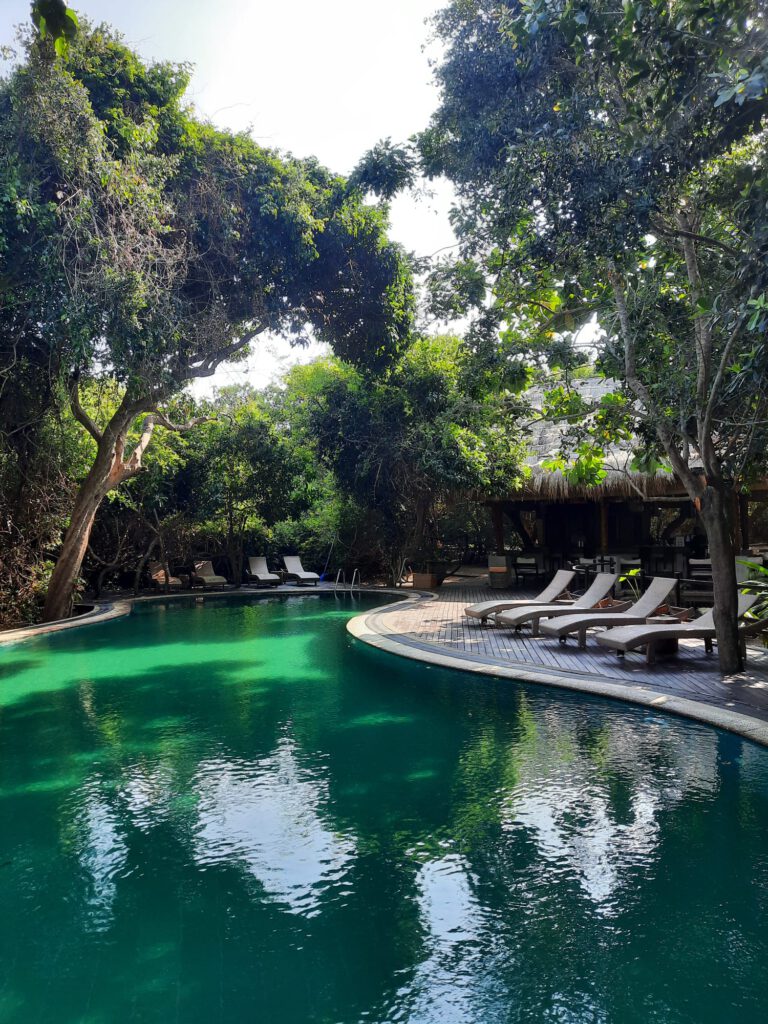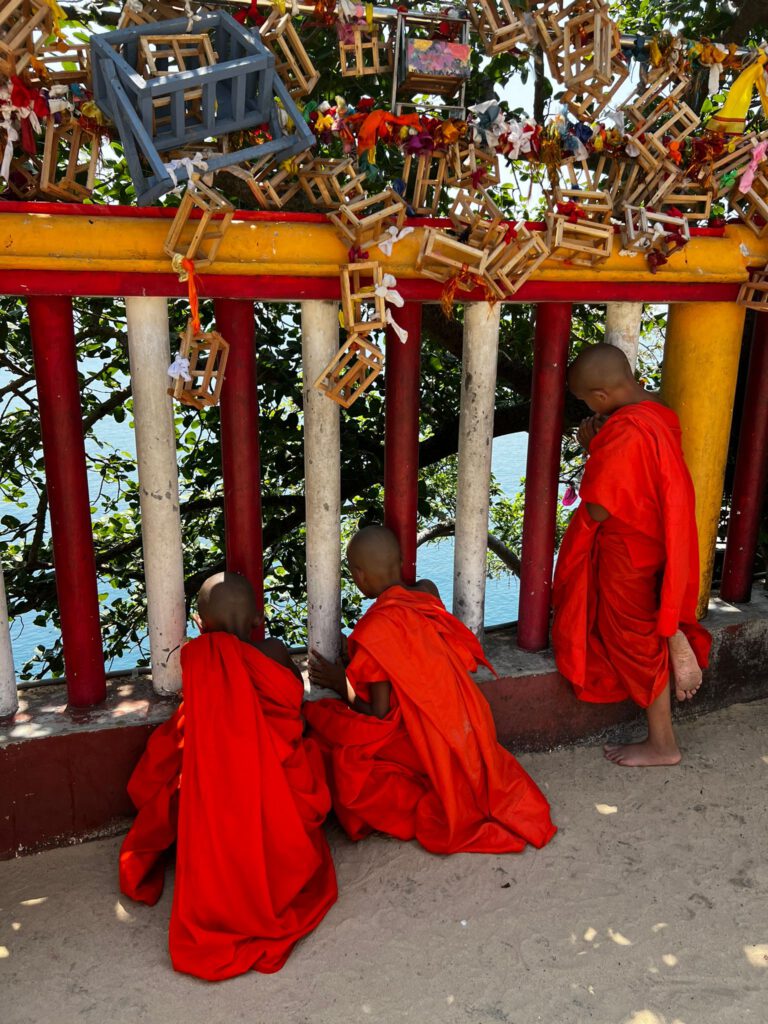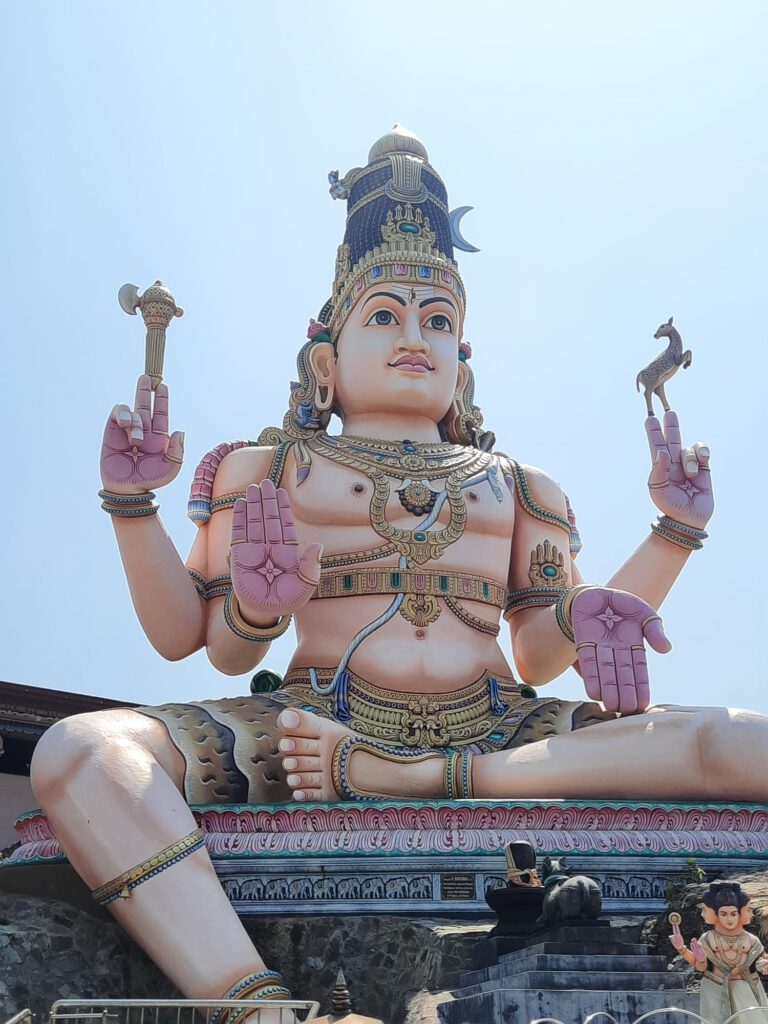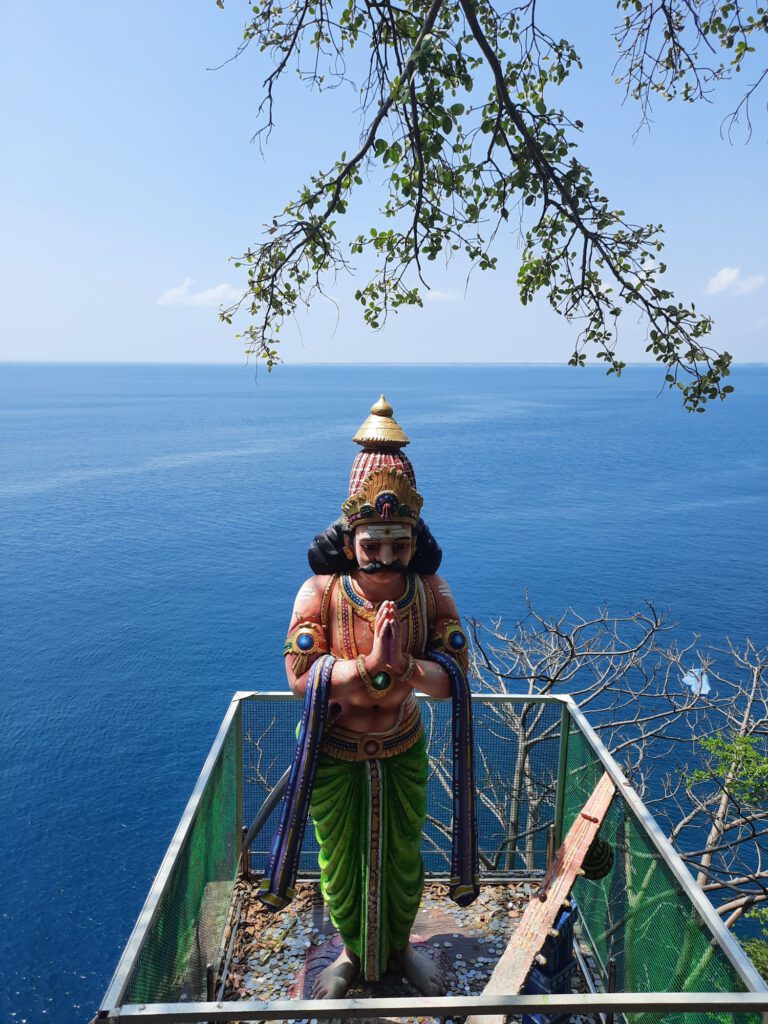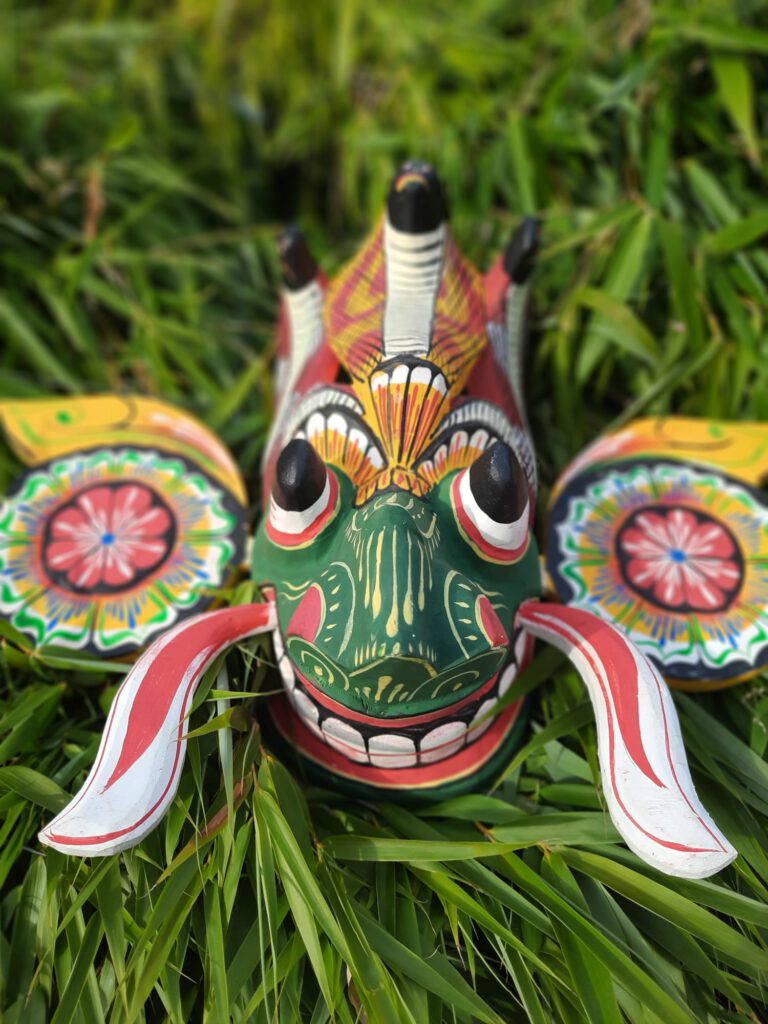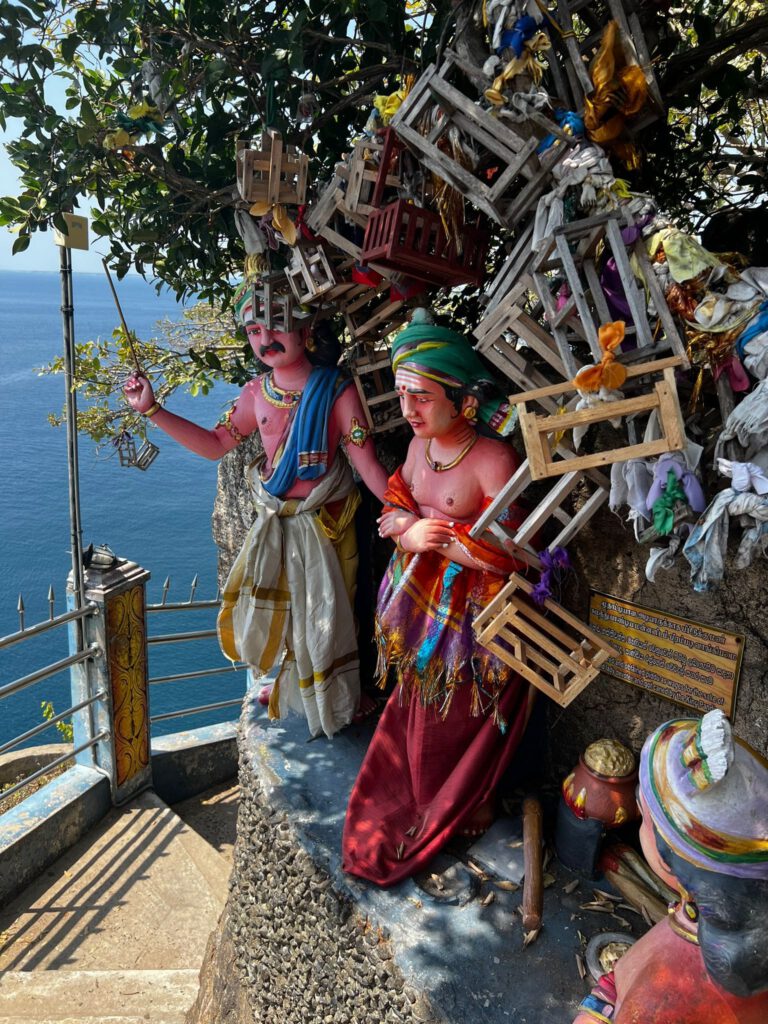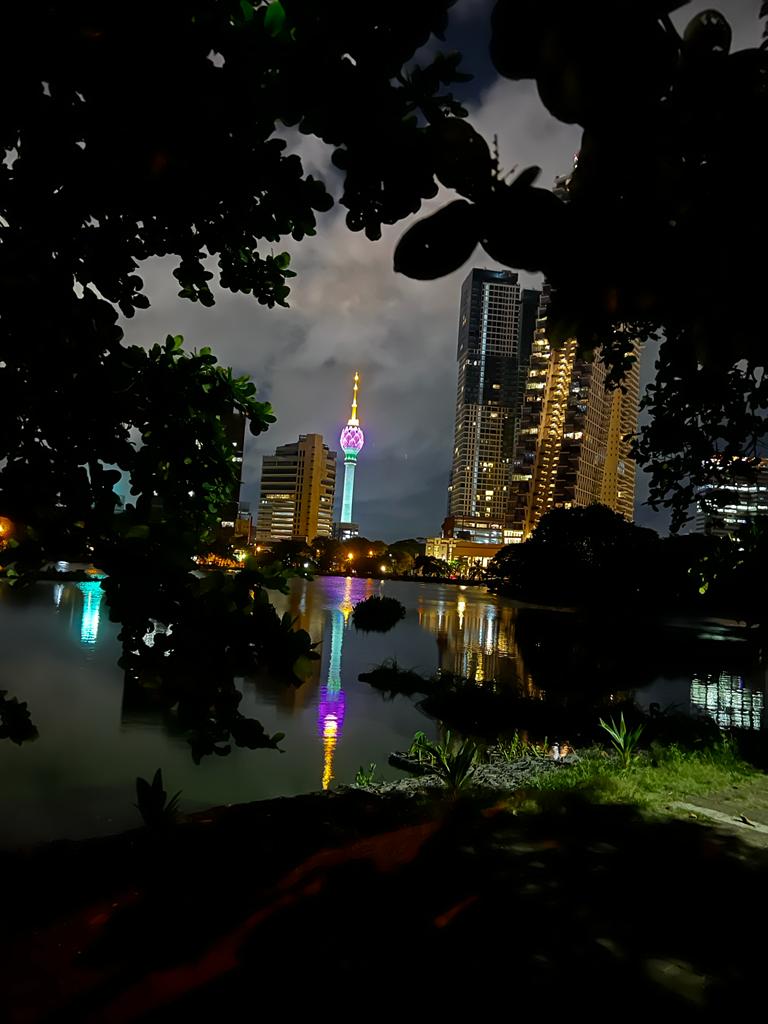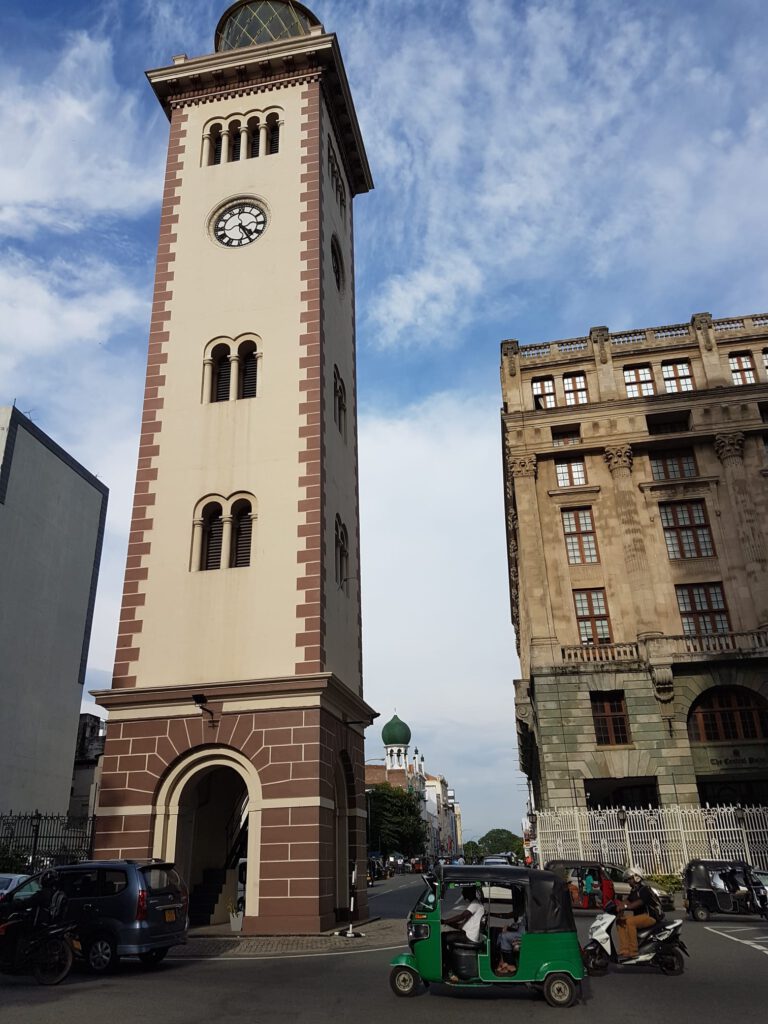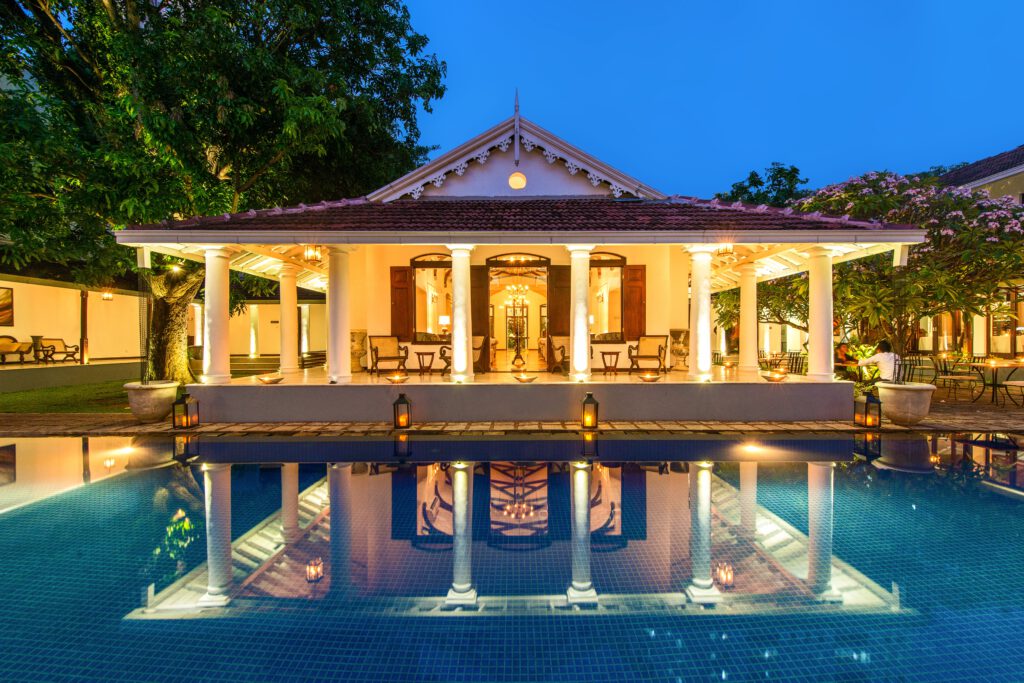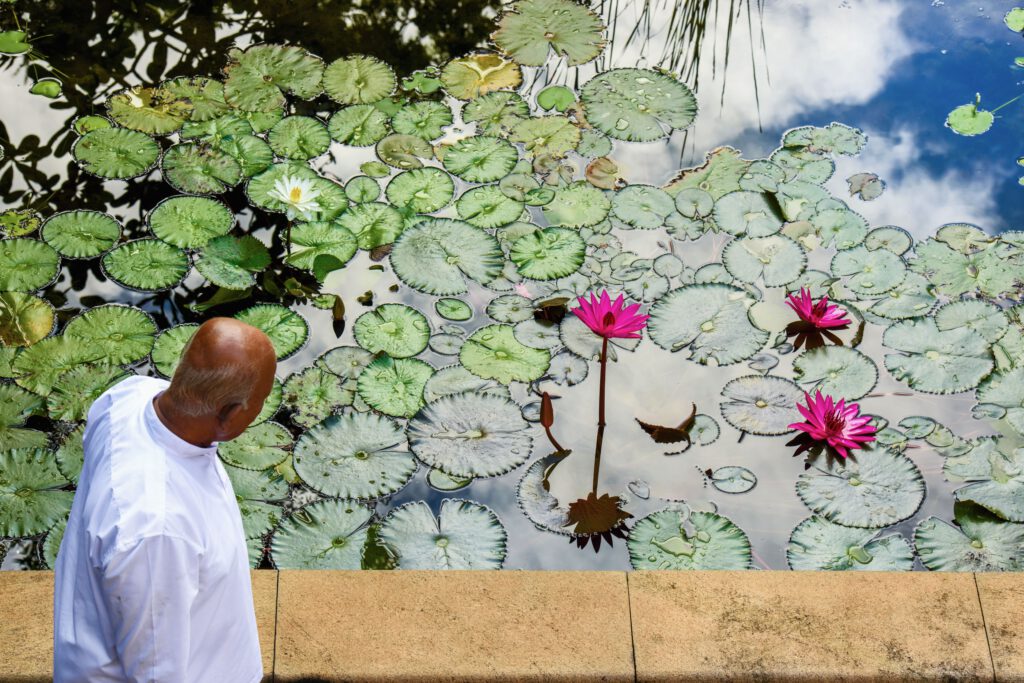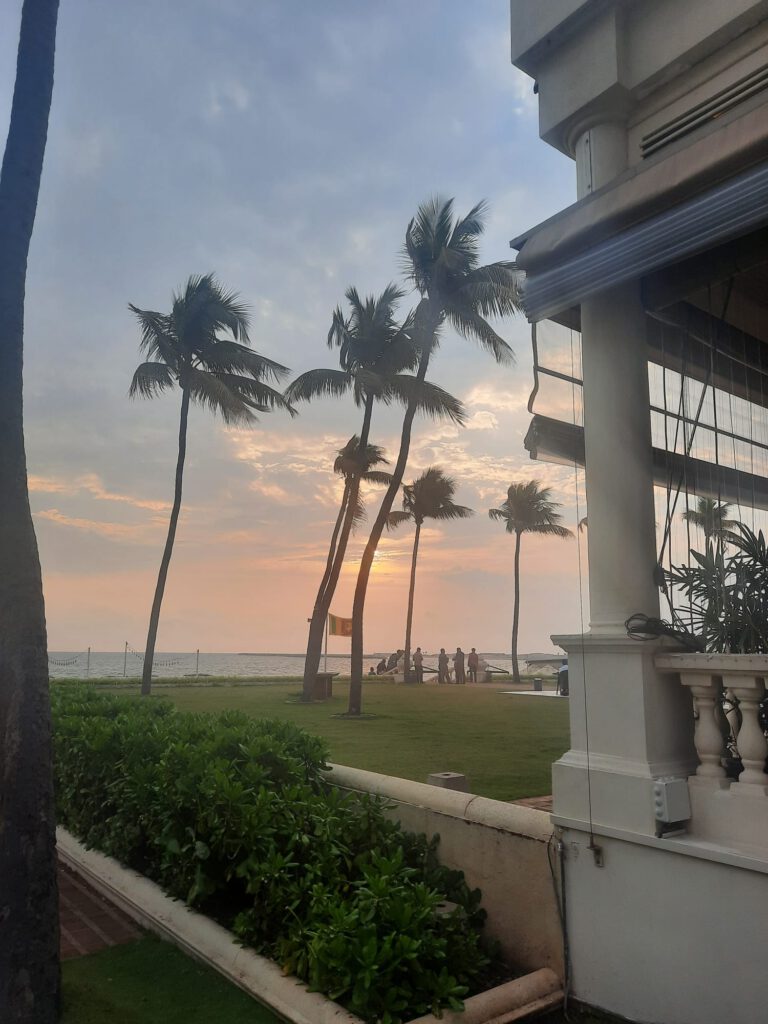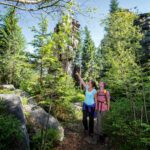
Green summer happiness in the north-east of Bavaria
23. June 2023Strolling adventures – with the Podi Menike to the heart of the island
It is pitch dark when the taxi driver drops us off at Fort Railway Station in the middle of Colombo shortly after 5 am. Rain drums down on the nostalgic station building of Sri Lanka’s capital. The British built the station in Victorian style a good 100 years ago when the island in the Indian Ocean was still called Ceylon. Families lie in deep sleep on palm-leaf mats in front of the aging façade decorated with half-columns, round arches and arcades. Masterless dogs stray past and typical street food is sold at the kiosk. Platform two is busy: women in colourful saris with children by the hand, men in jeans and suits, a few backpackers from Europe with big backpacks and we with our suitcases are standing in the tropical, steaming dawn waiting for the Podi Menike. That’s Sinhalese, means little girl, and the girl rumbles into the station right on time. The Podi Menike has been running from Colombo to Kandy since 1867 and on to Badulla in the central highlands since 1924, today twice a day. The train takes ten hours to cover the 292-kilometre distance, which was built at the instigation of the colonial plantation economy to transport first coffee and later tea from the highlands to the coast. Our train ride will be an adventure at a strolling pace.
We have booked tickets in the first, air-conditioned class to Kandy and one day later on to Ella. A bit of pushing and shoving on the track, then everyone is in the right carriage at their seats. Off we go. We have just made ourselves comfortable: the table is opened, notebook and pen are ready and we are happy to find out that the mobile phone is charging with the adapter at the socket. Then suddenly, at breakneck speed, we pack everything up again and get up. A train employee energetically turns over every seat in the direction of travel at high speed, and without making a face. Handbags, bags and umbrellas are now in the wrong places and are laughingly passed across the rows of seats. The brief chaos is acknowledged by everyone with cheerful composure.
Now on the road in the direction of travel, a tropical, luminous green backdrop passes by the window: metre-high banana trees, coconut palms and villages with corrugated iron roofs on which laundry lies to dry. Farmers stand knee-deep in mud in their rice fields and schoolgirls in white uniforms and long plaits walk under umbrellas to protect themselves from the sun. In Ambepussa, street vendors board the train: I can’t resist the lukewarm roasted peanuts – spicy – but I can’t get excited about the vegetarian dumplings and the chai tea with condensed milk for a few cents. I prefer to explore the train and leave first class, which is reminiscent of an older, German regional train in terms of design and comfort. At the transition to second and third class, all the doors are open and people are standing everywhere enjoying the breeze, filming and taking photos. The atmosphere is friendly, cheerful. In English, no longer an official language since 1957 but a compulsory language in the schools, you can strike up a conversation with almost everyone. I learn that the young couple from South Africa are on their honeymoon and the young woman from Colombo is on her way home to her parents in Kandy. We make a few jokes about how to get the best train selfie for Instagram and the like, then the train pulls into the station in Kandy and we get off.
Kandy is Sri Lanka’s second largest city, situated at an altitude of about 550 metres on the Mahaweli Ganga, the longest river on the island, and on Kandy Lake. The reservoir was created from 1807 onwards under King Sri Wickrema Rajasinghe. The last ruler of the kingdom of Kandy, who was exiled to South India by British colonial rule in 1815, can be seen in old photographs in a small archaeological museum on the grounds of the Temple of the Sacred Tooth Relic of Buddha (Sri Dalada Maligawa). The Tooth Temple is a national shrine and the spiritual centre of the island, and we also make a pilgrimage here.
The sight and the atmosphere are something very special: snow-white temple buildings with golden pagoda roofs, Buddhist flags, glass pavilions with hundreds of glowing sacrificial candles and pilgrims dressed in white on their way inside to the sacred chamber. Here, Buddha’s precious canine tooth is kept behind a silver-barred door. On the way there, one walks through dimly lit corridors past magnificent Buddha figures, in front of which the faithful place blue water lily blossoms, Sri Lanka’s national flower, as an offering. The walls are richly decorated with frescoes depicting elephant parades and dancers at the annual Kandy Esala Perahera held in August. It is magically beautiful! The surely unforgettable event in honour of Buddha as well as the four guardian deities is considered one of the most colourful festivals in Asia and takes place this year from 21 to 31 August. Actually, a tempting reason to go to Sri Lanka again (info: www.kandyesalaperahera.com).
My tip: Visit the Temple of the Tooth at around 6 pm, when it is atmospherically illuminated. The heat of the day has then subsided and as you may only enter the temple area barefoot, the soles of your feet are not „grilled“. In addition, the sacred chamber is opened only three times a day with a drum ceremony at 5.30 am, 9.30 am and just at 6.30 pm. Buy sacrificial flowers in front of the temple and, if necessary, borrow a cloth to cover your legs.
And a tip for another impressive experience: the traditional Kandy dances with dancing, singing, drumming and the Fire Walkers. A performance that will take every spectator’s breath away. The show takes place daily at 5 pm at the Red Cross Centre and lasts about one hour. Ask for ticket sales at the Tooth Temple.
My Hotel-Tipp for Kandy
The Cinnamon Hotels are a group of about 16 properties in the four- and five-star range. Most are in Sri Lanka and four in the Maldives. The Citadel Kandy is a four-star property with about 120 rooms and is located on a loop of the Mahaweli Ganga. From the restaurant with balcony terrace on the upper floor, the bar and the pool, you can enjoy a beautiful view of the river and the jungle opposite. The rooms are spacious, comfortable and very quiet. The food (buffet) is varied and good. The service is sometimes a bit slow, but always friendly. I found it great that the chef was happy to explain to me at breakfast the advantages of regional fruit, some of which was completely unknown to me.
One of Asia’s most beautiful train routes
From Kandy, the road goes uphill. The Podi Menike jogs at about 20 km per hour into the central, cooler highlands. Over countless tunnels, bridges and curves, the train winds its way up to just under 1900 metres above sea level at Pattipola and then the track drops again by about 1300 metres over a distance of only 65 km. The Podi Menike jolts and puffs upwards and everyone hangs on the windows or open doors. Outside, a picture-book emerald-green landscape of terraced tea plantations passes by, covering the landscape like a green carpet. Sometimes the plants are close enough to touch, as if the train is passing through a primeval forest-like garden, and then it rattles past again so close to a steep cliff that you can enjoy a breathtaking view over wide valleys and mountains. There is a high spirits on the train, everyone is flashed by the beauty of nature. They chat, film and take photos, even the locals who regularly travel along the route. A definite plus: Travelling by train is still a collective experience here.
Many people get off the bus in the bustling market town of Hatton, including many who have the 2243-metre Adam’s Peak as their goal. For many Sinhalese, Tamils, Hindus and Christians, climbing Adam’s Peak over 5200 steps once in a lifetime is a dream. After all, not only Buddha is said to have stood on the cone-shaped peak, but also God Shiva and Adam, who was expelled from paradise. Next time, I’ll be there too, for the sunrise!
One of the next stations is Nanuoya, from here you can be in the former British summer resort of Nuwara Eilya in no time, which is supposed to look like Little England. But we continue our journey, stretching our feet at small, pretty stations like Rozelle, where the Podi Menike makes room for the oncoming train and has to wait. A few minutes later, the stationmaster in a smart, snow-white uniform raises his ladle and we jolt off again. A few more tunnels and we are on time at our final stop, Ella, seven hours after leaving Kandy, only about 180 km away. And I regret a little that we didn’t book the Podi Menike to the final stop in Badulla. Because shortly after Ella near Demodara, the railway line runs over a 900-metre-long roundabout loop – it must be a masterpiece of engineering. The so-called Demodara Loop is supposedly inspired by a train worker who retied his turban.
But we change to the next adventure in Ella.
Train tickets: www.railway.gov.lk
By tuk-tuk through tea plantations
A small railway station and many young backpackers from all over the world, arriving or departing with their large backpacks on the two tracks. Ella has been considered a traveller stronghold in the southern hill country for years, and the tiny town at around 1050 metres above sea level is lined with chilled cafés and casual eateries catering to visitors‘ tastes from mojito to macchiato. Souvenir shops, Ayurvedic spa salons, plenty of guesthouses and small hotels dot the green hills. What makes it special is the breathtakingly beautiful, bright green mountain landscape with gushing waterfalls, tea plantations, the somewhat cooler climate and the hiking opportunities. The hotels and guesthouses with the best views are located on the so-called Ella Gap with a breathtaking view of the valley incision between the 1141-metre-high Little Adam’s Peak and the approximately 200-metre-high Ella Rock. We check into The Mountains Heaven, which is terraced on the escarpment, descend the stairs to the lobby and stand right in front of this view – great cinema! (for more information see hotel tips).
I booked our excursion for the following day in advance from Germany and was curious to see whether the Sri Lanka Trekking Club would pick us up at the hotel at 9 am. And indeed, right on time, Deen, a likeable, middle-aged man with a mottled grey beard, and a canary-yellow tuk-tuk are standing in front of the door. Without any exaggeration, it is a dreamlike day in a fascinating landscape with impressive encounters, during which we learn a lot.
With the wind blowing around our noses, we sit in the tuk-tuk heading for Bandarawela, by the way a surprisingly solid vehicle even on steep bumpy roads. Our destination is the Nayabedda Estate, according to Deen, a member of the Ethical Tea Partnership.
The Nayabedda Estate is one of hundreds of tea plantations in Sri Lanka, ranging from the lowlands to the high altitudes between 1400 and 1800 metres. Sri Lanka is now the world’s fifth-largest tea producer and third-largest exporter, although Deen says yields and sales are declining, probably due to the severe economic crisis in the heavily indebted island nation and the resulting lack of money for sufficient fertiliser, for example.
We learn from Deen that only the top three tea leaves are picked every six days, 95 percent by hand. The leaves are then fermented in the tea factories around Kandy into black, green and the finest leaves into white tea, and the majority is sold in 25 kg packages at the tea auction in Colombo, which was founded at the end of the 19th century. But not all of it goes into the tea cups of the world. Some of it stays on the island, because Sri Lankans like to drink a lot of tea. If you can do without fancy packaging with a label, you can buy your favourite quality in the desired quantity from one of the tea and spice traders, for example in Bandarawela on the main street, just like the locals. Note: 50 grams are rarely sold here.
I do not like to drink tea often. I am more interested in the people who work hard every day for the enjoyment of others‘ tea and their meagre income. These are the pickers, 80 percent of them women, mostly Tamils and increasingly also guest workers from Thailand, India, Pakistan, New Caledonia or the Caribbean. We meet a group of women workers fairly high up on the tea plantation on a steep slope that would make any black ski slope in the Alps pale into insignificance. They pick with a dexterous speed that makes me marvel and, although we can’t talk because I don’t speak Tamil and they don’t speak English, they meet me openly, friendly-cheerfully. This is not the case everywhere in the world. My attempts to pick off the top three leaves with a fixed twisting motion are rightly met with laughter. The women are incredibly fit, otherwise they would not be able to work for hours on the sometimes impossibly steep slopes, and often in scorching sun or heavy rain. Their palms are covered with thick calluses and yet they do without gloves that are provided to them, Deen tells us. They simply pick faster without them and about 16 to 40 kg a day, depending on the type of terrain. Supposedly they are paid a daily rate, but I don’t believe it. A little later I accompany the women to the scales: each has a small notebook and the quantity weighed is entered there. It looks more like the pickers are paid by the kilogram. And Deen didn’t want to tell me how much that is. It will be very little. Nevertheless, my impression is that I met a group of women who are content and not unhappy, who have their pride, are pleasantly friendly and reserved and clearly have a sense of humour.
Then back into the tuk-tuk and up the opposite ridge: The view from Lipton Seat is simply stunning. Valleys, mountains and tea plant carpets lie at your feet and Sir Thomas J. Lipton in life-size and in bronze reminds you that until about 1970 almost all tea plantations were still British-owned before insect-owned companies took over. So far, no Chinese investor is involved in the tea business here, says Deen.
The story of Glasgow self-made man and tea king Thomas Lipton (1848-1931), who made the tea bag a best-seller, is everywhere. He owned many tea estates here and the Lipton Seat was supposedly his favourite place and is located above his former Estate Mansion, where, according to Deen, royal guests once came and went and where the plantation manager lives today. A cup of tea with a strong note and lots of brown sugar and then a picnic with Deen. An all-round recommendable excursion to be booked at: www.srilankatrekkingclub.com
To the Instagram hotspot Nine Arches Bridge
Travelling to Ella without hiking is actually a no-go. But it was hot. Even though every travel guide praises the cool climate and says you have to have a jumper at hand and even make sure there is heating and warm blankets in the hotel, the bikini was my favourite item of clothing. So we at least hike to the Nine Arches Bridge, a nearly 60-minute tour. The approximately 100-year-old Nine Arches Bridge is a viaduct over which the Podi Menike runs twice a day. We reach it via a narrow jungle path and are not particularly surprised that travellers from all over the world have already positioned themselves with cameras, tripods and mobile phones to capture the best photo when the Podi Menike rattles across here. It’s an Instagram hotspot. We decide not to wait – too hot, the pool is calling – but to walk towards the train with plenty of time to spare. So we walk across the tracks as you probably wouldn’t anywhere else and 40 minutes later we walk into Ella station, where we got off the train the day before. Afterwards, a cold Lion’s at Love Café is delicious and then pool only, please, before we leave for our next adventure the next morning by private chauffeur.
My Hotel-Tip for Ella
The Mountain Heavens on Ella Gap is a lovely boutique hotel with about a dozen studio-style rooms with large windows and balconies. We had a terrace big enough for a dance party. The terraced house has a breathtaking view of the wide valley between Little Adam's Peak and Ella Rock and not only from all rooms, the restaurant terrace, but also from the pool. Dinner and breakfast both à la carte were excellent, the service tip-top.
www.mountainheavensella.com
or: www.resort98acres.com
and: www.ravanapoolclub.com
By chauffeur from the highlands to the north
Now it’s a steep downhill. We leave the southern highlands. The narrow country road meanders in countless curves into the plain towards the north. Our driver, Sineth Chathursha, does not speak a word. He sits concentrated at the wheel of his van, routinely drives over the serpentines, overtakes tuk-tuks and colourfully decorated public buses and is checked by the police a few times in the coming days. Not every driver has car insurance, but Sineth does, of course.
We met him an hour earlier. Right on time, he was standing in front of the hotel door in Ella to pick us up for the onward journey. We learn that he left in the early hours of the morning in Colombo, where the 32-year-old lives with his wife. He doesn’t want to take a break now, later. So we drive off.
It will be six hours before we reach the exceptionally beautiful, luxurious boutique hotel Uga Ulagalla, one of the five Uga Escapes on Sri Lanka, near the old royal city of Anuradhapura. I am full of anticipation. Five years ago, I had already stayed there for two nights as part of a press trip and could have stayed for a small eternity, that’s how much I liked it then.
After Matale, the landscape changes. No more metre-high jackfruit trees, coconut palms entwined with pepper vines, clove and cinnamon trees or vanilla bushes, but a flat, dry nature with only small hills, very hot and only now and then steep granite rocks provide variety. The nature resembles the African steppe and it is also possible that a few of the approximately 7000 to 8000 island elephants pass by the roadside. But the further north we drive, the more often there are large reservoirs along the way, some of which were dug by the early Sinhalese kings for irrigation. Rice fields, but also huge fruit and vegetable gardens are now part of the landscape near Dambulla. The bustling town is the main hub for pineapples to onions in the three halls of Sri Lanka’s most important wholesale market. Most travellers, however, go to Dambulla to visit the five Buddhist cave temples richly decorated with paintings and figures, which are UNESCO World Heritage Sites.
And now I must confess, we did not visit the caves. We were hungry, so Sineth took us to a typical Rice & Curry buffet restaurant, as we did often over the next few days, and we feasted on the fantastic variety of vegetables. My conclusion: I go weak over a lotus root curry spiced with chillies plus a roti (flatbread) or a hopper (thin rice pancake in the shape of a shell) with vegetables and coconut sambal. And even more so with wattalapam, a coconut pudding with cashew nuts and spices, like Christmas biscuits here.
A little later, we turn off a small road to the large wooden gate of Uga Ulagalla. The guard opens it and we stand at the entrance to a compound of about 23.5 hectares overlooking a perfectly maintained park with shady paths under giant trees, lush green rice fields, jungle on the outer borders and a lake covered with water lilies. At the entrance is the main house. It is a 150-year-old villa, lovingly renovated in country style, with an open veranda, bar, restaurant and a view of a glowing blue 25-metre pool. Peacocks stroll across the lawn and king squirrels shimmy through white-flowered, fragrant frangipani trees. Spread throughout the jungle-like park are 25 extremely spacious villas on stilts, each with its own small pool. We move into number 15 for the next three days – a beautiful, detached oasis furnished in a stylish mix of Sri Lankan and colonial elements (for more information see Hotel Tips below).
Climbing tour with a King’s Rock view
Cows walk past Buddhist flags waving in the wind and a monk in a saffron robe greets us with a smile. We are standing at the foot of the Pidurangala rock between Anuradhapura and Sigiriya. The sacred rock belongs to a monastery and at the entrance we pay 1000 Sri Lanka Rupees per person (about 2.80 Euros). With the income and additional donations, the monastery supports impoverished communities with such things as house renovation work and the education of children in the village. In addition, the monastery plans to rebuild the 5th century dagoba on the upper rock, where today only a field of rubble can be seen.
It takes us about 30 minutes to climb Pidurangala, first up high stone steps, past the remains of monk cells under rocky outcrops that are said to date back to the 5th century, and then past a twelve-metre-long reclining Buddha made of brick. Be careful not to put your foot in it when taking photos: Never turn your back on the Buddha statues.
Now the path becomes steeper and is blocked by large rocks. The last few metres you have to get down on all fours to get over the large boulders. But the sweaty effort is worth it: the wide panoramic view and the view of the rock fortress of Sigriya opposite, which King Kassapa built for himself in the 5th century as a luxurious refuge after he had his father walled up alive, is magnificent.
Most travellers visit King Kassapa’s Sigiriya Rock Fortress, a UNESCO World Heritage Site (entrance fee approx. 30 USD p. p.), which is why it can sometimes be quite crowded on the stairways to the top.
About Buddha’s wondrous skyscrapers
Our next stop is at one of the ticket offices in the holy city of Anuradhapura (ticket 25 US dollars p. p.). Like Kandy and Polonnawura, it is an ancient Sinhalese royal city and together they form the so-called cultural triangle. Until the first half of the 13th century, the kingdom flourished here in the north and in Anuradhapura from about the 3rd century BC to the 10th century.
Dagoba, stupa or pagoda – all three terms mean the same thing. Namely, buildings that house a relic, in this case allegedly various bones of Buddha, and enjoy cult status in Buddhism. In Anuradhapura, some of them are not only very old, but also of enormous size and were the largest brick buildings in the world until modern times. And when you stand in front of one of the mightiest in the centre of the extensive monastery complex, everyone is amazed. The impressive domed dome of Jetvana Vihara towers almost 71 metres into the sky over an area of 233 square metres. In ancient times, Jetvana Vihara was 122 metres high and famous as a wondrous skyscraper in the Buddhist world. At that time, it was also the third highest building on earth after the pyramids of Giza and the lighthouse of Alexandria. The twin building, the Abhayagiri Dagoba of the monastery to the north, also stretches up like an enormous cathedral with a base circumference of 120 metres.
The oldest stupa is the white Thuparama a little further on, surrounded by a stone forest of crooked pillars, supposedly the remains of a round temple whose roof was destroyed.
Most pilgrimage activity today, however, is at Ruwanweli Seya. The once ruinous stupa was rebuilt in the 19th century as a snow-white domed dome with a surrounding elephant wall, now the tallest at 103 metres high.
Tip: Buy sacrificial flowers at one of the many stalls, leave your shoes at the entrance and let yourself drift along with the pilgrims. If you want to see everything, you will need at least one day. The grounds of the Holy City are very large, so explore by bicycle or tuk-tuk and be sure to take enough drinks. It was very hot and the soles of our feet were once again „grilled“. The only relief was to wear stockings or walk around the dagobas in a hurry and then cool our feet at one of the water taps.
To the oldest tree planted by human hands
If you are not yet completely drenched in sweat and really only want to think about the wonderful hotel pool, you could visit the Bodhi tree just a little further on. It’s worth it! In the peaceful, spiritual atmosphere, you feel removed from the world. The large, spreading poplar fig tree fenced in by a golden lattice and surrounded by white, smaller temple buildings is said to be an offshoot of the tree from northern India under which the historical Buddha, Siddhartha Gautama, found his enlightenment at the age of 35. The offshoot is said to have been planted in Anuradhapura in 288 B.C. and is therefore considered the oldest tree planted by human hands. The many pilgrims who come here ask Buddha’s blessing for various intentions, such as pregnant women for healthy children or farmers donating the first grains of rice for a rich harvest.
Uga Ulagalla and the new Elephant Research Centre
Back in Uga Ulagalla, I feel very lucky. The boutique hotel is one of the nicest I have ever visited. It is the tranquillity, the complete privacy in the villa, but also the attentive service of the always friendly smiling staff, who can read almost every wish from your eyes, and the fine, freshly prepared food. But I also find the range of activities particularly attractive, from archery to guided nature walks, jeep safaris, canoeing, excursions into the surrounding area and a horseback ride to Ulagalla Lake. The sunset tour on the hotel horse Rolex was my personal, unforgettable highlight.
But you can also hop on one of the bicycles parked at each villa and go for a ride through the grounds. Cycle past the many bright green rice fields and watch white herons, colourful storks, ibises or peacocks, or amuse yourself with a family of monkeys gyrating wildly in the bushes. At least as long as it is light. When darkness falls, it is safer to be picked up at the villa. It is not elephants, leopards or sloth bears that are to be feared – they usually make themselves scarce and would be hard to miss – but snakes. Sri Lanka has 80 different species, including venomous ones like the king cobra, the Ceylon krait or the chain viper. But don’t worry, I didn’t see a single snake.
The tropical fauna of the island with many endemic species is interesting and the tour leader who coordinates all guest activities in Uga Ulagalla is a great person to talk to if you want to learn more. Anna Katharina Raaben comes from Germany, is married to a Sri Lankan and worked in several countries in Africa before she started in Uga Ulagalla.
„The hotel has its own water treatment plant, own sewage treatment plant, solar power and vegetable gardens inside and outside the compound and we try as much as possible to produce fruits and vegetables ourselves and buy them from farmers. And since July 2022, we also have our own Elephant Research Centre, also to improve the interaction between people and animals,“ Anna Katharina Raaben says.
She says the idea came about during the Corona period, when she started observing the elephants that appeared on the edge of the hotel grounds. „In 2021, the first one was there. A bull with powerful tusks. Only five percent of elephants have tusks,“ Anna Katharina Raaben reports. By 2022, she and her team had already spotted over 100 elephants on the hotel grounds, also thanks to newly installed wildlife cameras. „There are 200 to 300 elephants living nearby, we know today. They often come when there is a full moon, on what is called the Poya night in Buddhism. Elephants don’t see so well and the light is better when the moon is full. Also, people are busy on Poya night. They are free and visit the temples.“
The 70 families living in the adjacent village, like all the farmers on the island, are not thrilled when they get elephant visitors. Every day, an elephant devours about 200 kilograms of greenery, especially sugar cane, bananas or rice plants. If a whole herd shows up, nothing is left of the harvest. „People store their supplies and crops in their bedrooms or living rooms. They are simple houses. If an elephant smells that, it suddenly stands in the bedroom and eats everything,“ she says. Therefore, people try to protect their property and watch over their land from small tree houses that can often be seen along the country roads.
„If one appears, they first try to scare it away with torches and shouts, then they use firecrackers, which are provided free of charge by the government, and if that doesn’t work, they shoot. Sometimes, Anna Katharina Raaben says, they also put out bait, namely watermelons filled with firecrackers. „They then explode in the mouth and the badly injured elephant starves to death.“ Therefore, Uga Escapes have created a remedy that works well and have sponsored and installed a Village Fence so that the interaction between the 70 families in the neighbouring village of Uga Ulagalla and the elephants runs better. „This is a special sturdy electric fence that has been installed around the entire village and is in operation from 6pm to 6am. The electric shock is strong enough for deterrence, but does not hurt the animal unlike the many homemade electric fences on the island,“ Anna Katharina Raaben reports on the successful project.
My tip: Go on a jeep safari with Katharina and her team, and with a bit of luck see elephants, but certainly many other animals.
Romantic Kamatha dinner and firefly magic
Torches flicker in the darkness, Buddhist flags wave gently in the evening breeze and at the end of the path a table is set under a mighty tree next to a traditional wooden house, from which it smells temptingly good. To start the Kamatha dinner, we are served a fine arrack cocktail with a spicy curry leaf (arrack is a typical local spirit often distilled from sugar cane).
Around us lie the rice fields of Uga Ulagalla, shimmering in the darkness, and we feel as if we are on a distant, romantic island. And indeed, Kamatha also means something like an island. It is the term for a piece of pure land dedicated to Buddha, located in the middle of the fields. It is the traditional place where farmers and their family gather to eat together, where festivals and ancient rituals are celebrated with warm hospitality in harmony with nature. So, in the heart of Kamatha, we take a candlelit seat on cinnamon wood chairs and savour the incredible variety of traditional Ayurvedic curry dishes that come to the table in countless small bowls and dishes. It is a delicious, healthy meal with lots of vegetables and fine spices. And of course we visit the cooks in their wooden house, where they prepare everything fresh on an open fire and let us in on the secrets of the old recipes that have been passed down through generations in the family. It is an unforgettably beautiful evening and my tip is: Definitely book a Kamatha dinner.
On the way back to the villa under the twinkling starry sky, the hotel employee in the electric car takes us on an extra round. There were so many fireflies on the move that he had to show us. We stop in a grove of trees: Thousands of glowing fireflies dart through the air. It is a magical sight like something out of an Avatar movie scene! Uga Ulagalla is a place that makes home on the other side of the world fade away.
Sweet idleness on the dream beach of the east coast
The thermometer shows 38 degrees Celsius, not a cloud in the sky and the Indian Ocean rolls onto the beach in pleasant waves. We lie under the parasol with an iced lime juice and read. Every thirty minutes we dive into the waves, shoals of tiny fish dart around us. Then back to the sunbed, not a soul on the eternally long sandy beach, just the Russian couple a little further on and a lifeguard sitting in a Baywatch hut. Every now and then the waiter Nevill hurries across the hot sand to see if we need anything. Then he hurries back into the shade of the beach bar.
We spend a week at Uga Jungle Beach on the east coast, about 25 kilometres north of Trincomalee. After the adventurous week before, the sweet idleness is just right. For a few days, we just do the total relax thing: From breakfast with lots of delicious, fresh fruit and exotic, freshly squeezed juices like from the prickly pear or from the fruit of the bubble gum tree, we go to the beach, have a light snack at the beach bar for lunch and then mostly to the pool, because it is much cooler there. The pool is beautifully laid out like a lagoon in the jungle, framed by mighty soap and pot fruit trees, whose filigree giant blossoms are an eye-catcher. In the evening, we go to the restaurant for dinner and then back to the beach bar, where we meet Sineth for a drink. The Beach Bar is our favourite place and that is also due to Nevill and his colleagues. They go to so much trouble to make our holidays special. Twice we book a beach dinner with lobster, tuna, big prawns all fresh from the grill – it’s delicious. While we eat, we look at about 40 small boats whose lamps conjure up swaying cones of light on the waves. These are the fishermen from the neighbouring village who go out every evening and fetch the delicacies on our plate from the sea off the coast.
A tip for early risers: The sunrise around 5.30 a.m. here on the east coast is a blast. A glowing red ball rises above the sea.
Sharks and turtles up close off Pigeon Island
The motorboat glides over the Indian Ocean glistening in the sun. Next to me sits an employee of Uga Jungle Beach, who accompanies us on the excursion to Pigeon Island. The tiny Pigeon Island, named after the rock dove that breeds here, lies two kilometres off the coast of Nilaveli and has been a national park since 2010 because one of the few coral reefs on the east coast lies around the islet. Ahmn Sandaruwan, one of the hotel’s lifeguards, drives us across the sea for an hour until we reach Pigeon Island to snorkel off the coast.
The view of the underwater world is ravishing: confetti-coloured, tropical fish are on the move among the lush corals. Sometimes there are large shoals that stand in front of us like a silvery wall, dodging in formation to match our swimming movements – fascinating. Several green sea turtles „sail“ past and we watch a turtle about one metre in size eating for minutes at a time from very close quarters as it gobbles down the green seaweed morsels. And at first we don’t notice that we are being watched too. A blacktip reef shark swims around us just a few metres away. We continue snorkelling, but we keep our distance and he stays close by. I am impressed, especially as the elegant animal with the black spot on its dorsal fin is about my size, 1.70 metres. Then he dives down and disappears into the dark depths.
In the heaven of the Hindus
As a European observer, you don’t know where to look first. The figures are particularly colourful and seem bizarre to our eyes. Open mouths, many arms, countless heads and animals, also as mixed creatures, and the largest of all is usually Shiva. He is the most popular Hindu deity and often has a trident in his hand, a crescent in his hair and his mount is Nandi, a white bull. His family is also always present like his wives Durga and Paravati, his elephant-headed son Ganesh and Vishnu comes flying on the bird Garuda when there are problems to solve.
A Hindu temple is a must-see. It is an exotic cosmos that astonishes. We visited several and the Thiru Koneswaram Kovil temple in Trincomalee (a thirty-minute drive from Uga Jungle Beach) is particularly impressive. It is located on a rocky outcrop rising above the sea in the middle of Fort Frederick, which was built by the European colonialists and is now used by the Sri Lankan army. Next to the main temple, one discovers trees decorated with flags and figures and niches along a narrow path above the cliff with a wide view of the ocean.
You may only enter the temple barefoot and your legs must be covered. Walking back, you pass many stalls with carved, whimsical wooden masks. These are kolam or gara yaka masks, used in traditional dances to drive away devilish spirits. They often hang at the entrance of houses for protection or good luck and are made in large numbers for tourists as souvenirs.
From Trincomalee to Colombo
Sineth drives us from the north-east coast across the island to the south-west coast: We stop one last time at a Rice & Curry restaurant and we go on safari in Habarana and see elephants. In the evening we reach Colombo. Now two more days of sightseeing, meeting friends and on the third night Sineth drives us to the airport. A fantastic road trip has come to an end.
„It is better to travel well than to arrive.“
Buddha
Colombo – exotic, hot, exciting
Brightly coloured tuk-tuks rattle around the clock and lighthouse in the old fort district. Women in colourful saris stroll past renovated colonial buildings, some of which house American coffee house and fast food chains. Sri Lanka’s capital of 2.5 million inhabitants, Colombo, is an exciting metropolis where past and future mix. Next to modern skyscrapers like the Bank of Ceylon (as Sri Lanka was called until 1972) stand colonial splendour buildings like the snow-white presidential palace or the old post office built by the British in 1896. Everything here breathes history: first the Dutch had dominion over Ceylon’s cinnamon gardens and then the island state in the Indian Ocean belonged to the British Empire and was an important stopover on the way to the Far East.
I learn all this during a city walk with Mark Forbes, who comes from Colombo and is a „Dutch Burger“, i.e. his ancestors come from Holland (www.colombocitywalks.com). While strolling through the old fort district, we pass the former hospital of the Dutch. Where 300 years ago the sick smoked an opium pipe for anaesthesia, today cosy cafés, nice restaurants or pretty shops invite you to linger, such as the Ministry of Crab, which was voted Asia’s 50 best restaurants in 2022, or the beautiful shop of the Spa Ceylon chain. For going out in the evening, the restaurants on Park Street are great, where Colombo’s scene meets in former, chicly converted warehouses. Around the corner is the Gangaramaya Temple on Beira Lake. On a full moon night, you have to walk here and mingle with the many people celebrating Poya.
On Sir Baron Street, Cargills, Colombo’s oldest department stores‘, catches the eye. It is the parent store of a supermarket chain, named after the Scotsman David Sime Cargill, who opened his first shop here in 1844. Right across the street we taste delicious street food: Chinese Roll, Pati and Wade are small dumplings with spicy filling and cost a few rupees.
Thus fortified, we stroll a little further to marvel at the magnificent view of the harbour from a tiny balcony on the fourth floor of the Grand Oriental Hotel, which has clearly seen better days. Sipping an iced gin and tonic, we look out over a massive construction site. The China Communications Construction Company, which is largely owned by the Chinese state, is building a new district here, the Colombo Port City.
And then it gets exciting: in a tuk-tuk, we drive through the hustle and bustle of traffic with the wind blowing around our noses to the bazaar district of Pettah. The narrow streets are bustling with life, with countless shops selling fine Ceylon tea and fragrant spices. And in the middle of it all, a mosque from a thousand and one nights: the red-and-white Jami ul Alfar is huge, with room for thousands of people. The architect is said to have thought of a sliced pomegranate when designing it. Tip: Visitors are allowed to climb to the roof of the mosque at certain times. The view over minarets and red-and-white striped turrets must be sensational.
But I want to buy a Kandy-style sari, so I head for the nearest shop in the Pettah district. From the outside, it looks inconspicuous, but inside, on three floors, there are saris galore, in all colours and qualities, from simple cotton to heavy silk embroidered with glittering stones. I feel overwhelmed and am about to turn on my heel when two gentlemen approach me, one a sales advisor, the other responsible for the fitting. Half an hour later, I’m standing on a platform being wrapped in six metres of pink silk! My husband’s comment: You look like the Statue of Liberty! But the Sri Lankan gentlemen in the shop are thrilled and so am I, by the way, so I buy it! However, I don’t know when I will wear the sari at home and if so, certainly only with the help of a Youtube video. But for the next trip to Sri Lanka or India, I have the right garment in my luggage.
My Hotel-Tips:
The Uga Escapes: The Sri Lankan hotel group consists of five luxurious five-star boutique hotels that I like very much. I have already stayed in four of them.
The Uga Residence in Colombo has a great location in the heart of the city with Park Street and Gangaramaya Temple around the corner and we spent the last few nights here. The boutique hotel with ten classically elegant junior suites and one suite was built as a Victorian city palace surrounded by a park by a wealthy sheik in the 19th century. The who's who of Ceylon's colonial society once came and went here, such as governors, nobility or maharajas. Everything here breathes history and the inner courtyard with pool, restaurant and bar, around which the suites are arranged in an arcade, offers a film-like setting. After a day of sightseeing in Colombo, the Uga Residence is the perfect tranquil oasis to relax, enjoy high tea or end the day with dinner in the atmospherically lit courtyard. The service and food are first class and the staff are all very accommodating.
Uga Ulagalla is an exceptionally beautiful, exclusive boutique hotel with 25 very spacious, luxurious villas on stilts near Anuradhapura, all with their own pool. It is my personal hotspot and I have described it in detail in the articles above.
The Uga Jungle Beach is the most exclusive hotel resort on the east coast in Kuchchaveli and is located 25 kilometres north of Trincomalee between a lagoon and the sea on a kilometre-long, fine sandy beach. A dream for those seeking peace and quiet! On the beautiful, jungle-like hotel grounds are 50 tastefully, simply furnished bungalows either with a sea or lagoon view or in the jungle itself. Breakfast or dinner is served at the table, in the evening as a choice menu. My tip: Be sure to book the beach dinner with seafood from the grill - a romantic dream on the beach by candlelight. There is a small spa and also excursions such as bicycle tours to temples in the area or boat tours to Pigeon Island or to watch dolphins and, at certain times, whales.
Uga Bay is three hours' drive further south in Pasikuda, also on the east coast, right on the tropical beach. I don't know the Uga Bay personally, but I guess it is also very nice and I assume it has a bigger spa than the Jungle Beach.
The Uga Chena Huts are located in the southwest at Yala National Park between the beach and the jungle. The hotel is perfect for going on safari and seeing three of Sri Lanka's 'Big Five' - Asian elephant, leopard and sloth bear. In addition, you can see monkeys, birds or even large monitor lizards. The rest of the Big Five - namely blue whales and sperm whales - can be seen on the coast of Mirissa at certain times. The Chena Huts have well-trained rangers who go on safari with the guests in jeeps. At the Chena Huts, guests stay in luxurious, detached, enchantingly furnished "huts" with their own pool. There are 18 of them, spread over a large area. A restaurant with terrace and beach view (you cannot swim in the sea here, the surf and currents are dangerous) and a large pool are included
More information: www.ugaescapes.com
Hotel-Tip for Colombo
The four-star Galle Face Hotel is very famous. Colombo's oldest hotel opened in 1864 and countless international celebrities have stayed here - from royalty to pop stars. It's right on the seafront and the 150 or so colonial-style rooms with large marble bathrooms are spread across the north and south wings. There is fine dining and a veranda restaurant - super nice. You sit almost regally in wicker armchairs under whirring fans overlooking the setting sun above the beach (you can't swim, too dangerous). The massages at the spa are heavenly and reasonably priced. We spent our first night here, partly because the Fort Railway Station is only a few minutes' drive away.
More info: www.gallefacehotel.com
Private chauffeur
If you want to travel with a private driver, I recommend Sineth Chathursha. He is a professional driver, also drives government officials occasionally, speaks English of course, is reliable, helpful, likeable, always drives a tip-top clean, air-conditioned, insured van and he organises the best route and also spontaneous extra requests. I really wanted to go on an elephant safari on the way back from the east coast to Colombo. Sineth makes a few phone calls and we change to a jeep in Habarana and shortly afterwards observe a herd of elephants. In short: Sineth is a treasure.
You can contact him via Whatsapp: +94776388381
His daily rate: from 50 euros
Drivers have a valued status in Sri Lanka. They are accommodated by the vast majority of hotels free of charge with full board in the staff house. If it should be a small boutique hotel, a nearby accommodation is arranged. This has to be paid for then. It is very cheap. If you stop for a meal at a restaurant on the way, or if the driver accompanies his clients to a museum or to the Holy City in Anuradhapura, for example, no meal, no entrance fee has to be paid for him. He is there free of charge. And of course you give a tip after the last ride.
Flight
If you want to fly with Sri Lankan Airline, I do recommend Ritscher Tourismus, Email: info@ritscher-touristik.de. And for expeditors support@pep-flug.de
We flew with Sri Lankan Airline in Economy on an Airbus 330. My conclusion: The Eco is comparable to the Premium Eco at Condor.
SL Eco has plenty of legroom, footrest and adjustable headrest and an adjustable recline angle on the seat. On-board entertainment and meals are included in the price and do not have to be booked as modules at extra cost. Blankets and pillows are also standard on long-haul flights.
On Sri Lankan Airline, you can also order vegetarian food in advance online. The stewardesses wear pretty blue saris with peacock-eye patterns. I like that.
Fotocredit: Uga Escapes (8), Petra Kirsch.



